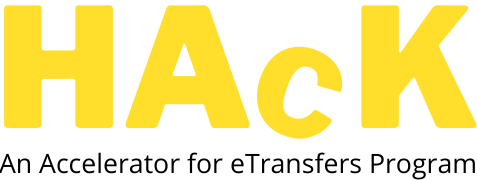HAcK at Transfer Bridge to UCLA Samueli Engineering is a summer accelerator program designed to provide incoming engineering transfer students an opportunity to ‘get their hands dirty’ on a technical engineering design project; to utilize their math, science, and engineering concepts; to gain some professional development; and to have some fun.
Welcome to HAcK 2022!
About HAcK
During Basic Training, HAcKers received a crash course on engineering design tools that they will use during HAcK’s technical competition. Through this experience you will hone these skills, better understand the iterative design process, and engineering work.
HAcK is designed to challenge you. Not just with utilizing the skills you’ve learned; but, also in applying them in an effective way with the time that you have. Let’s see what you and your group can do in these few days. What will you walk away with?
Through this challenge you will learn what it’s like to be an actual engineer! How are you going to deal with hardware issues? How are you going to work with someone on the other side of the planet? How are you going to make sure that everyone has something to do? But most importantly, you guys are going to have fun with your friends in the accelerator program and build something all by yourself.

Photo from Basic Training 2022
Time Remaining at HAcK 2022
Day(s)
:
Hour(s)
:
Minute(s)
:
Second(s)
2022 Winners
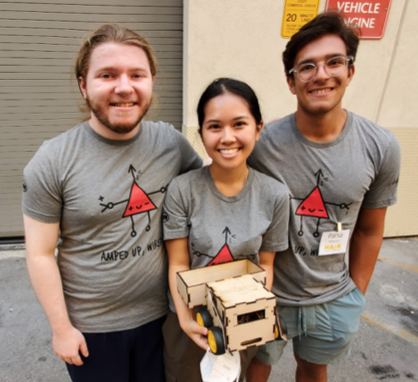

First Place Winner
Steven Bash, Moorpark College, Computer Science
Lynne Duong, Orange Coast College, Mechanical Engineering
Parsa Mazloumin, Chapman University, Civil & Environmental Engineering
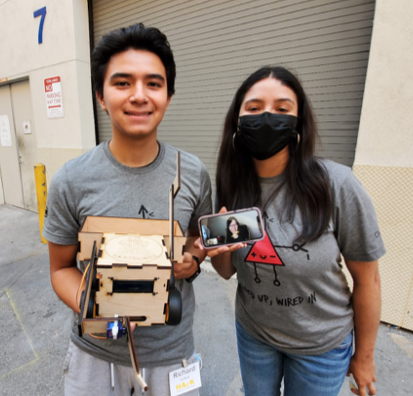
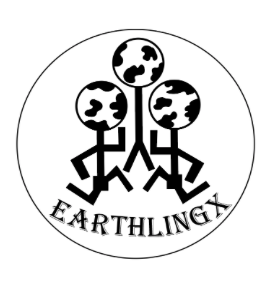
Second Place Winner
Jingwen ‘Jaelyn’ Fan, De Anza College, Computer Science
Laura Gonzalez, Ventura College, Electrical Engineering
Richard Sandoval, Moorpark College, Aerospace Engineering

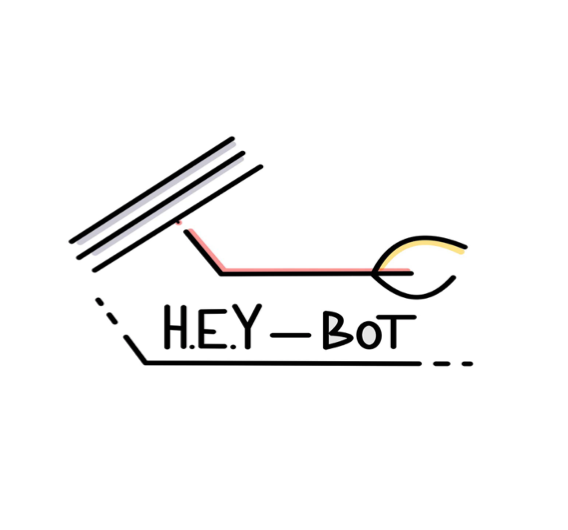
Third Place Winner
Shile Huang, Mt San Antonio College, Electrical Engineering
William Escobar, Los Angeles Valley College, Electrical Engineering
Yulong Yu, Chabot College, Mechanical Engineering
Honorable Mentions

Best Logo: Alien Years
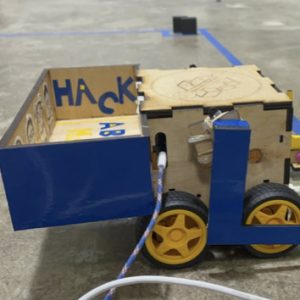
Best Aesthetics: Absolute HAcKers
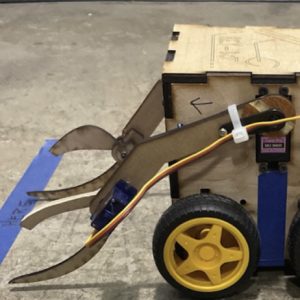
Most Sophisticated Arm Design: H.E.Y-Bot

Most Organized Interior: The Martian Maniacs

Coolest LCD Screen: Free Block-E
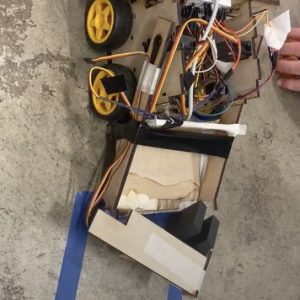
Coolest Pickup: Eclipse Robotics
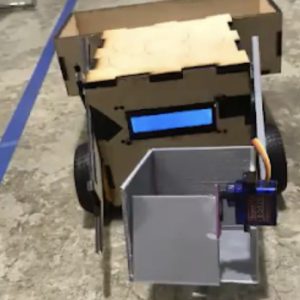
Best Use of 3D Printing: RGB
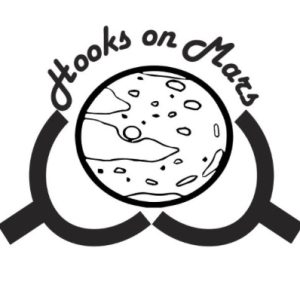
Best Music Taste: Hooks on Mars (Cupid Shuffle)
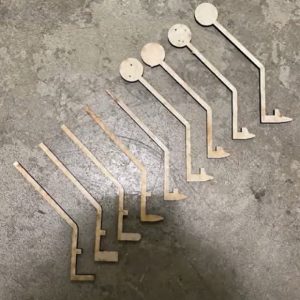
Most Iterative Designs: MACH10

Best Dance: EarthlingX
Schedule
Monday, July 18, 2022 | 6 – 9 PM | virtual
HAcK Orientation (Welcome, Introductions, What Will be Covered)
Tuesday, July 19, 2022 | 6 – 9 PM | virtual
HAcK Training Day 1: UART and Bluetooth
UART I
UART II
UART III
Bluetooth I
Bluetooth II
Introduction to Motor Drivers
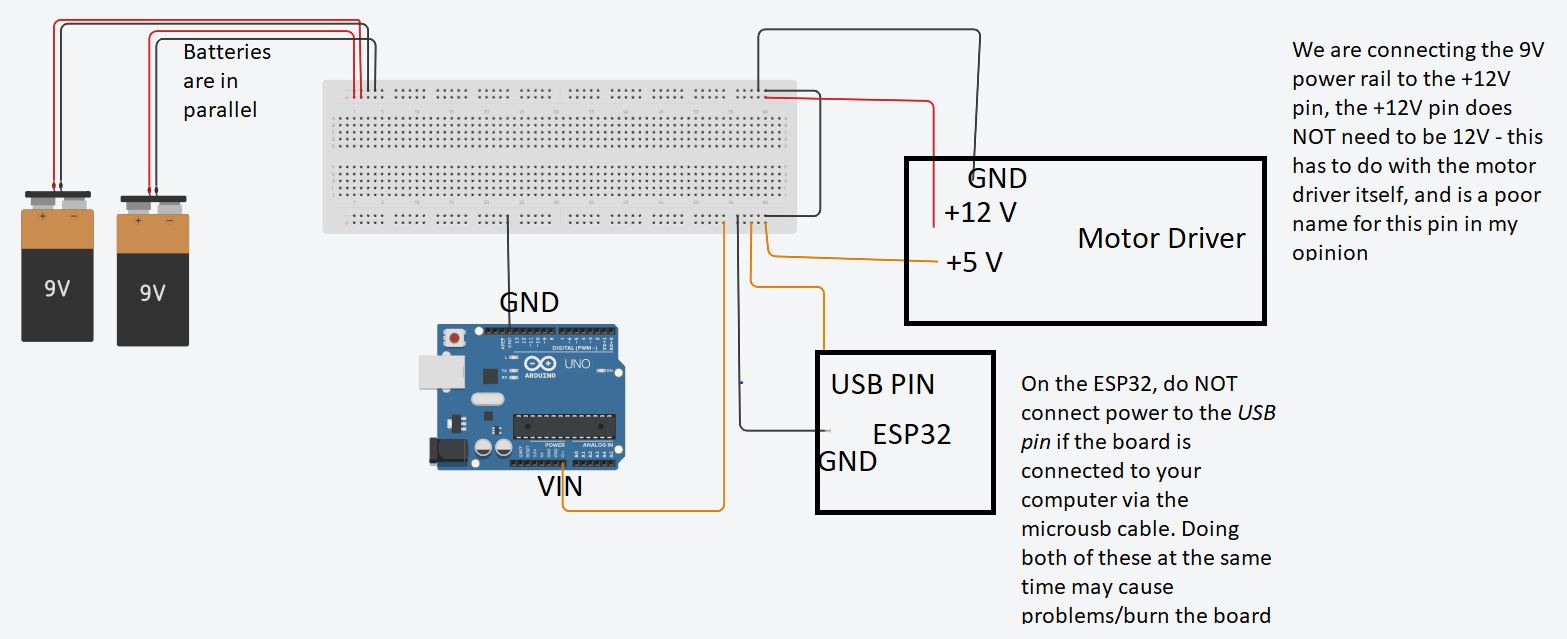
The diagram above indicates how to power your microcontrollers without using wired connections to a computer. Do not connect +9V to either microcontroller – the Motor Driver provides +5V (acts as a 5V battery) through the +5V pin. Use this pin to power both the Arduino (through VIN) and the ESP32 (through USB). Do not connect the ESP32’s USB pin to power while the microusb is connected. Either of these may be done separately, but may cause issues if BOTH are connected at the same time.
Wednesday, July 20, 2022 | 6 – 9 PM | virtual
HAcK Training Day 2: LCDs and Bonus Assemblies
~Please note that you can access Basic Training materials here.
LCD I
LCD II
LCD III
Thursday, July 21, 2022 | 6 – 9 PM | virtual
HAcK Reveal and Team Announcements
HAcK Competition
Day 1 – Friday, July 22, 2022 | 9:30 AM – 10 PM | In-person or remote (if out of area)
Boelter Hall 2730 (9:30 – 5 PM) – hit the Map, Directions, and Parking link below
UCLA Innovation Lab (5 – 10 PM)
Day 2 – Saturday, July 23, 2022 | 11 AM – 10 PM | In-person or remote (if out of area)
UCLA Innovation Lab
Day 3 – Sunday, July 24, 2022 | 9:30 AM – 10 PM | In-person or remote (if out of area)
UCLA Innovation Lab
Tuesday, July 26, 2022 | 10 AM
Deadline to submit design review presentation
Friday, July 29, 2021 | 6 – 9 PM | virtual
HAcK Competition Awards Ceremony
Benchmarks and Timeline
Friday July 22nd:
- Team registration is due.
- CAD files for the HAcK technical project will be released at 9:30 AM.
- MakerSpace will be open at 5 PM.
- Teams should have finished design work for their first prototype and begun assembly by the end of the day.
Saturday July 23rd:
- Field of play for prototype testing will be open at the start of the day.
- Teams should have tested their first prototype by the end of the day.
Sunday July 24th:
- After 10 PM, teams can make no more modifications to their project.
- All photos and videos to be used for team presentations must be taken during HAcK (prior to 10 PM Sunday).
- All CAD and code files used will be due.
The Challenge
Stage I: Building a Chassis
Welcome to Mars, colonists. Recently a rocket has crashed in the vicinity of the colony. The rocket was carrying a load of valuable parts that we need to maintain our life support systems. But the crash has caused the radioactive fuel to contaminate the crash site. It is best that we use robots to recover the much-needed parts!
We have provided you with some materials to build a robot that can traverse the crash site. Assemble the robot chassis and make sure the robot can move in any direction.
Objective: Assemble the robot chassis and control it with Bluetooth
1. Assemble the body and internal electrical components according to guidelines
2. Set up Bluetooth control on your laptop and remotely drive your robot

Stage II: Designing and Building Arms
Unfortunately, the overseers do not have enough time to design the arms for the robot. It is up to you to design and assemble the arms of the robot so that it can recover the parts and put them into its backpack.

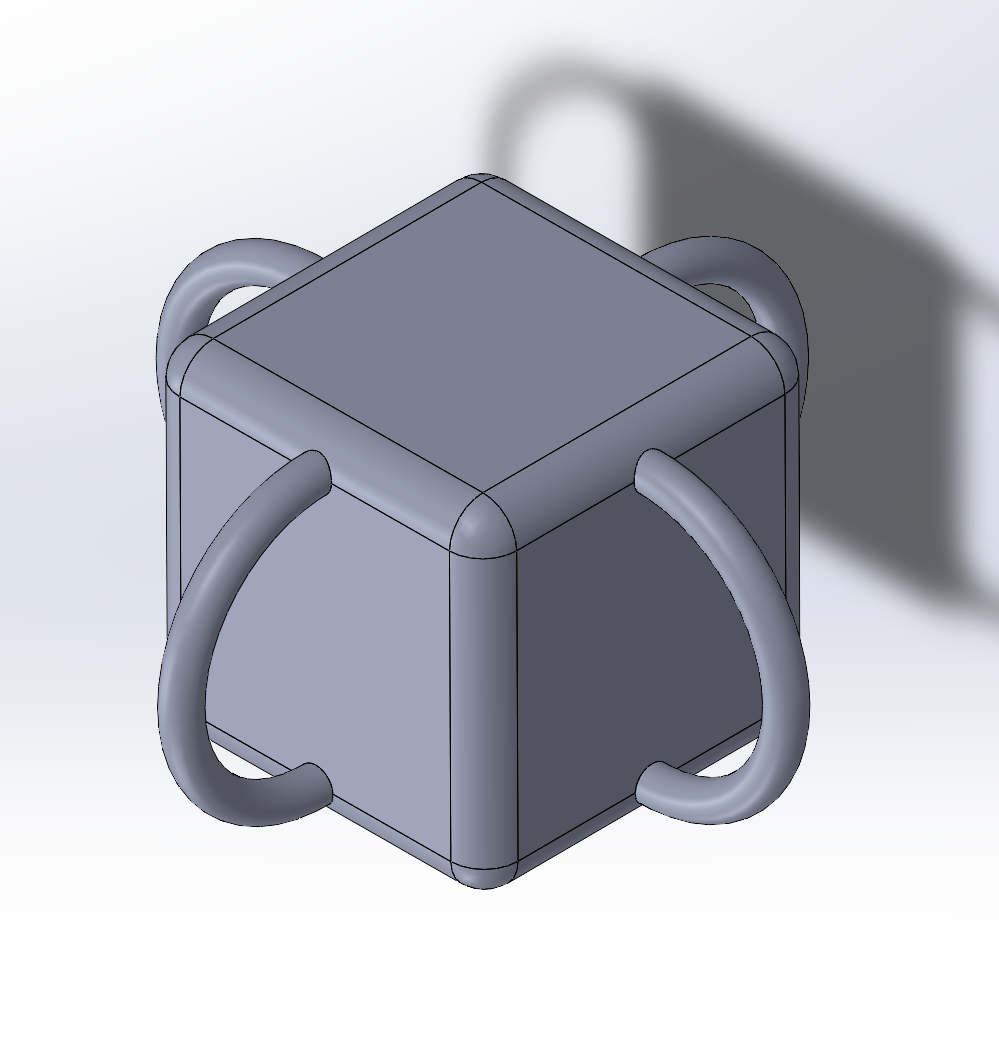
The TIE Fighter
The Atomic Death Star
Objective: Design and build arms that can collect the parts and load them into the backpack
1. Design arms that can pick up the parts
2. Prototype your design. We have provided ample raw materials, laser cutters and 3D printers
3. Mount the arms onto the robot and make sure the arms are functional
Stage III: The Robots are Becoming Alive!
The cosmic electromagnetic forces influence the planet of Mars in ways the human mind cannot comprehend! You feel as if your robot is coming alive! What is the robot trying to communicate to its human overlords? Perhaps it wants to express its emotions. Help your robot express it emotions.
Objective: Program the LCD screen on the robot to express different emotions
1. Code different displays for different emotions for your robot
2. Enable your robot to display different emotions while performing different tasks
*Be creative! Robot emotions cannot be readily understood by human minds!
Stage IV: Transcendence
“Dance is the hidden language of the soul.” — Martha Graham
The robots have gained sentience! They now want to transcend their mortal duties and become one with their Deus Ex Machina. Of course, they cannot communicate advanced spiritual ideologies. The only way they can express their heavenly desires is through dancing.
Objective: Enable your robot to dance
1. Design a dance sequence in your robot’s program
2. Let your robot dance in the most free, beautiful choreography witnessed by man!
Here are the CAD files for HAcK!
https://drive.google.com/file/d/17JO-AKAl-8rYtIvQ8qpU2Ssg-2iCPaIS/view?usp=sharing
Field of Play
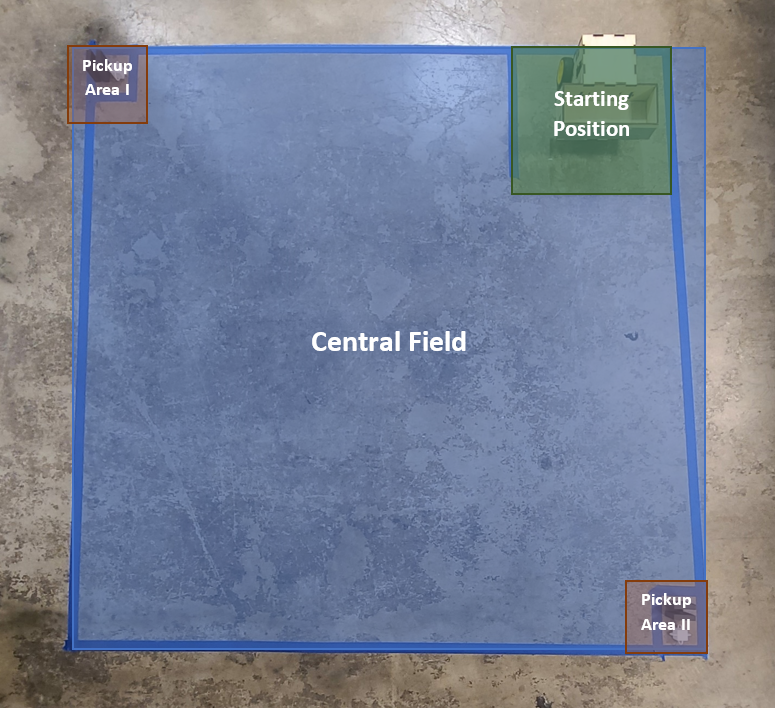
Starting Position
The Starting position is located at the top right corner of the field.
The Block-E will be placed in the Starting position before begining its operation. It MUST be placed with its blackpack towards the central field and its face towards the edge of the field.
The Block-E MUST move backwards out of the Starting position to initiate its operations.
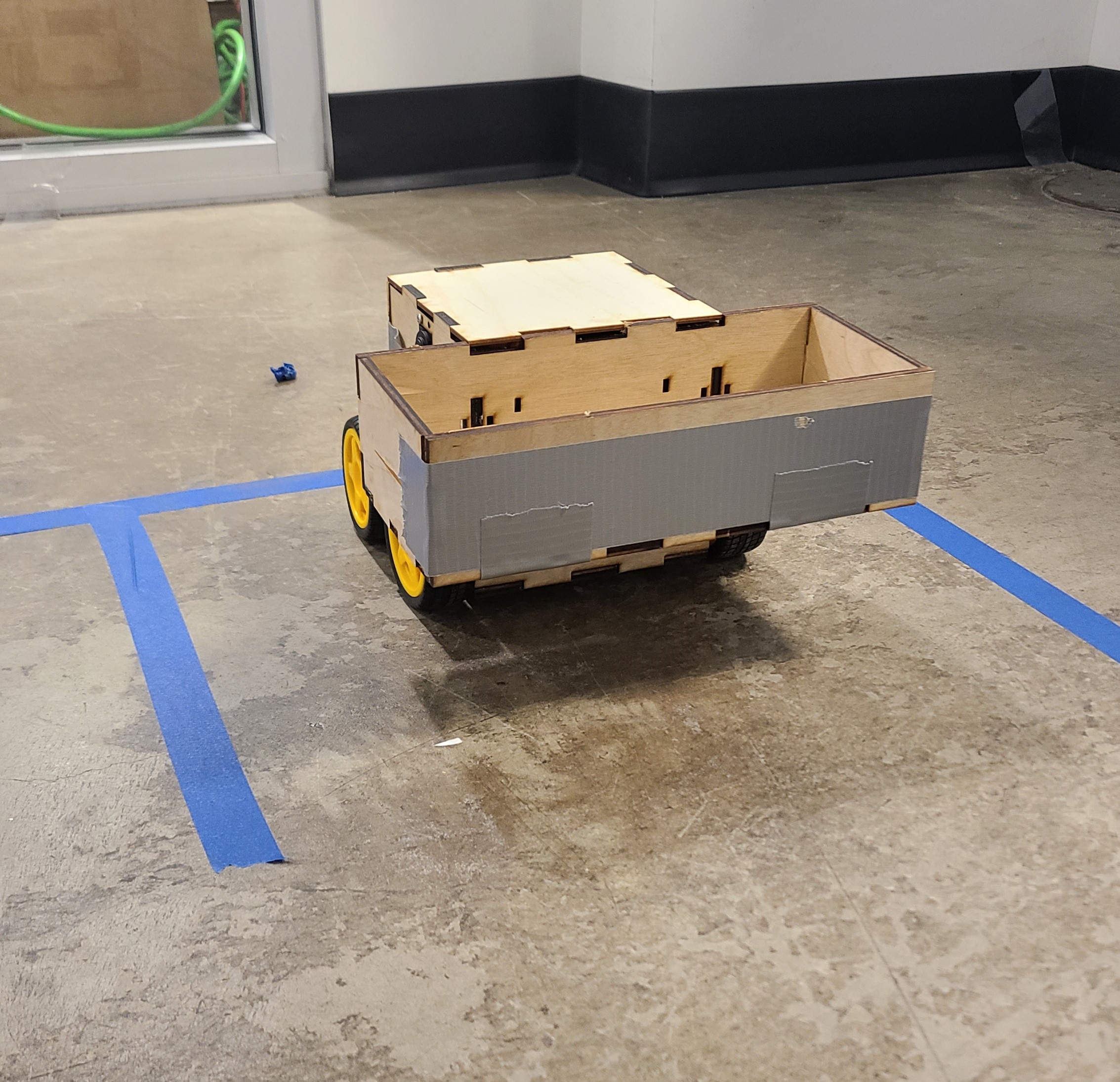
![20220722_134828[21261]](https://etransfercenter.seas.ucla.edu/wp-content/uploads/etransfercenter/20220722_13482821261.jpg)
Pickup Areas
The Pickup areas are where the parts are placed. The parts are placed on the floor. The Block-E needs to pick up these parts and place them into its backpack.
There are two Pickup areas, the first located at the top left edge of the field and the second located at the bottom right edge of the field.


Central Field
The Central field is the large empty space connecting the Starting position and Pickup areas.
Your Block-E needs to traverse through the Central field to reach the Pickup areas. It is a space where you can show off your Block-E’s abilities! Whether it be its swift motroic skills, vivid LCD facial illustrations, or its breath-taking choreography 🙂

Rules of Engagement
To preserve the spirt of good competition and keep the challenge interesting and meaningful as a technical design experience, teams will be required to follow a list of requirements outlined below.
Please DO NOT begin assembly or inspection of parts provided until the HAcK is revealed! Teams that show up to HAcK with parts assembled in any form will be disqualified.

Prohibited Items & Things to Bring
- Students will NOT be allowed to bring in or use personal hardware components or use their personal equipment (3D printers, etc.), otherwise specified. These provide an unfair advantage to teams with members who are familiar with or have access to tools that other participants do not. Teams run the risk of being disqualified. Please check with a mentor when in doubt.
- Use of outside software or libraries is allowed (provided that it is freely available online) for design analysis or algorithm enhancement. However, Accelerator Mentors will NOT provide training for any software other than the ones mentioned previously in workshops.
- NO USC stuff.
- Please bring your laptop, face mask, closed-toed shoes and water bottle (no water will be provided by HAcK).
- Please bring food and snacks as you need (no refrigeration provided).
HAcK 2022 Parts
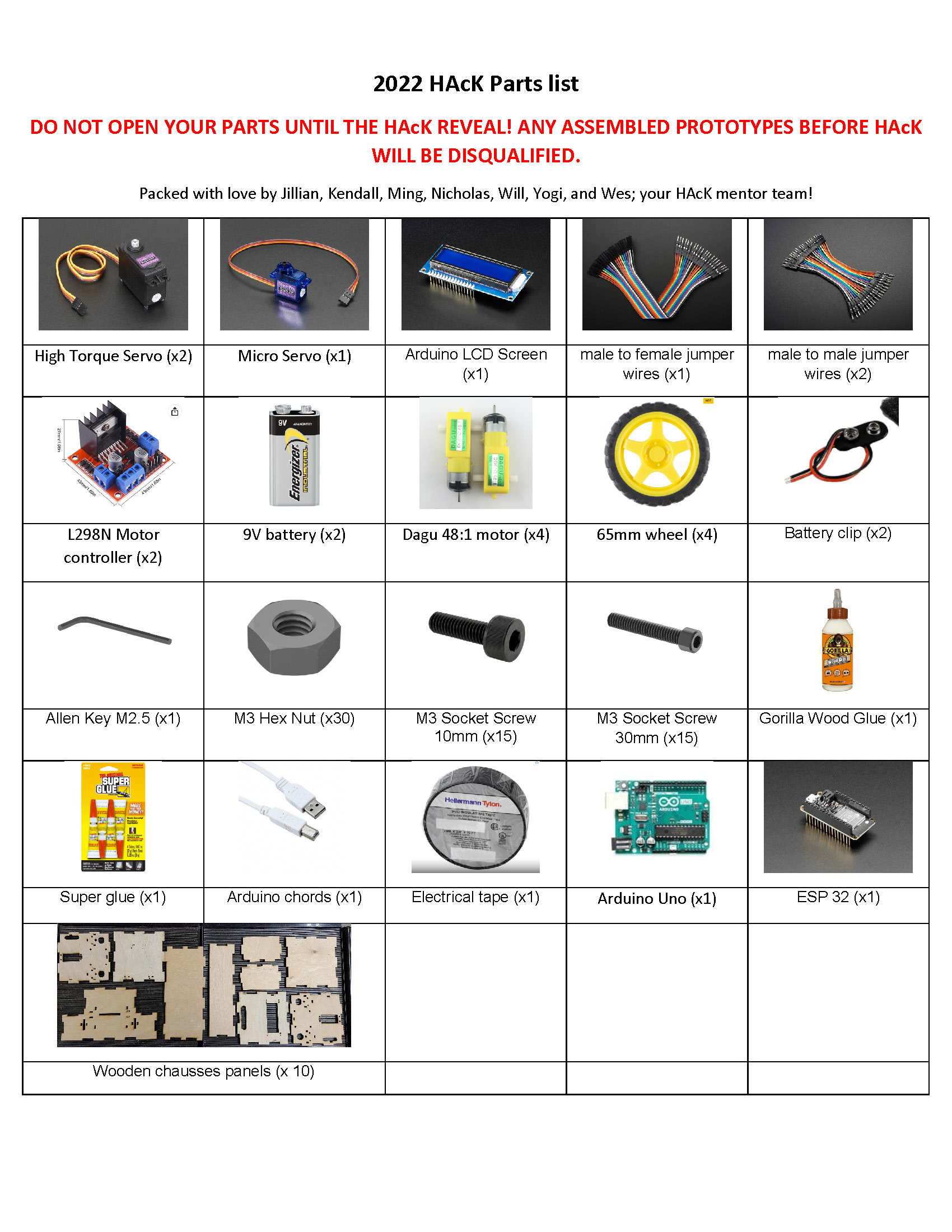
HAcK 2022 parts list
Please note that certain items were purchased in large quantities to accommodate participants. Please check unit column to determine what is needed per participant. Also, DaguRobot was used because other vendors were out of stock.
Standard Operating Procedures – Tools in the Makerspace
Laser Cutter
If you have parts that needs to be laser cutted, contact any mentor available and they will help you out with laser cutting.
DO NOT operate the laser cutter unsupervised.
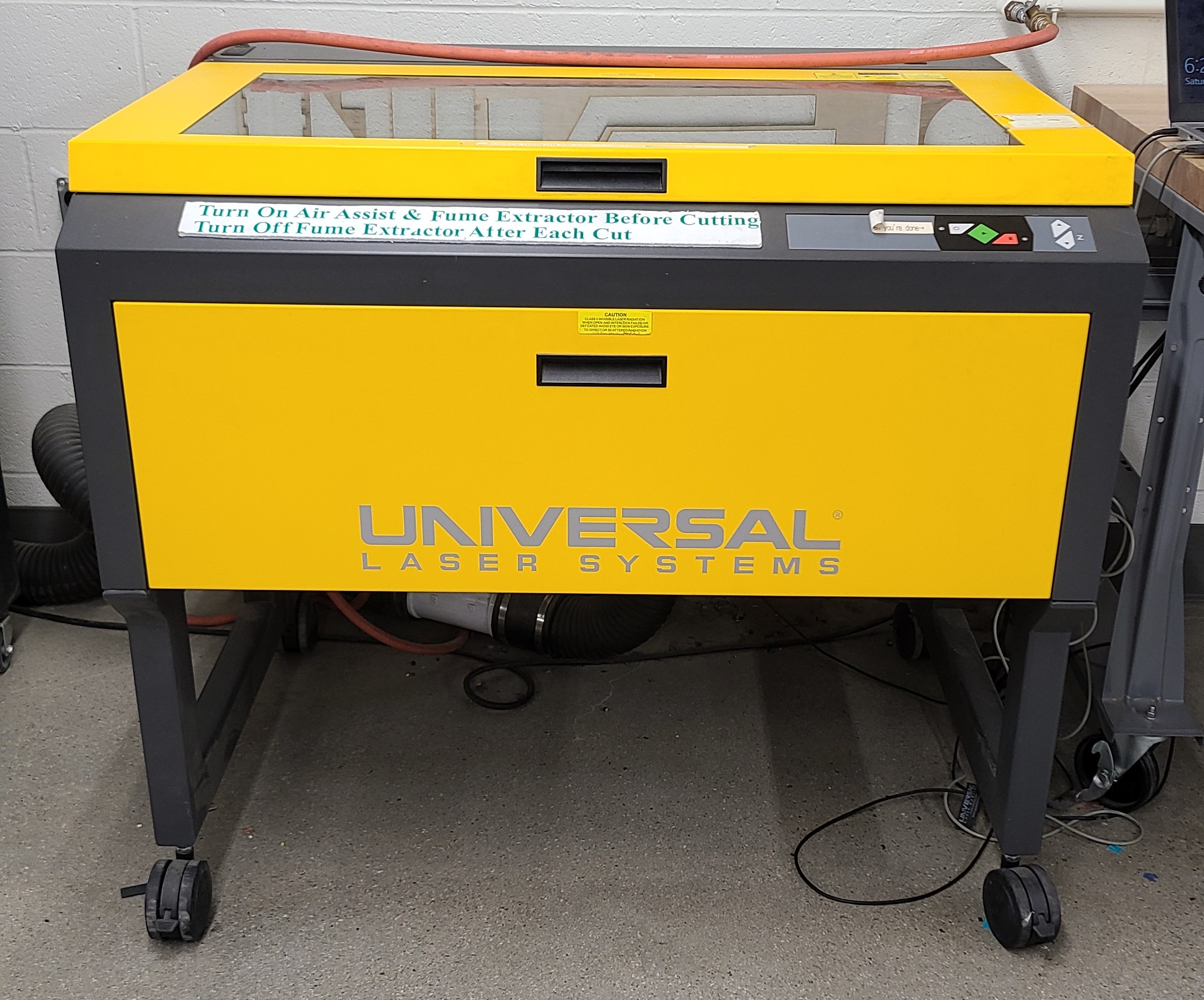
3D Printer
If you have parts that needs to be 3D printed, contact any mentor available and they will help you out with 3D printing.
DO NOT operate the 3D printer unsupervised.
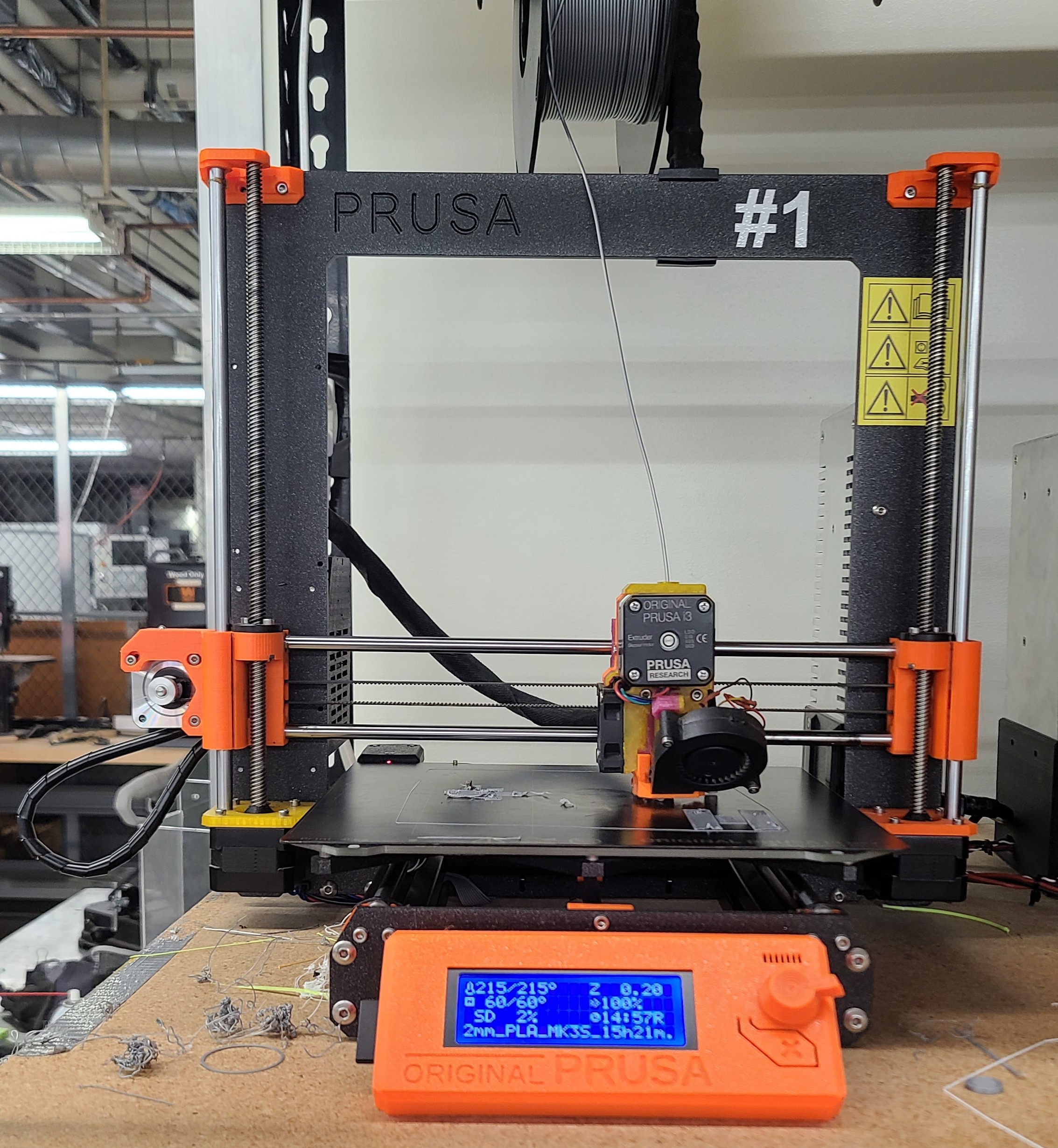
Hand Tools
You can freely choose any available hand tools and use them in any manner except:
- DO NOT harm yourself or others
- DO NOT destroy the tools in the makerspace
- Always return the tool to where you found it after using it
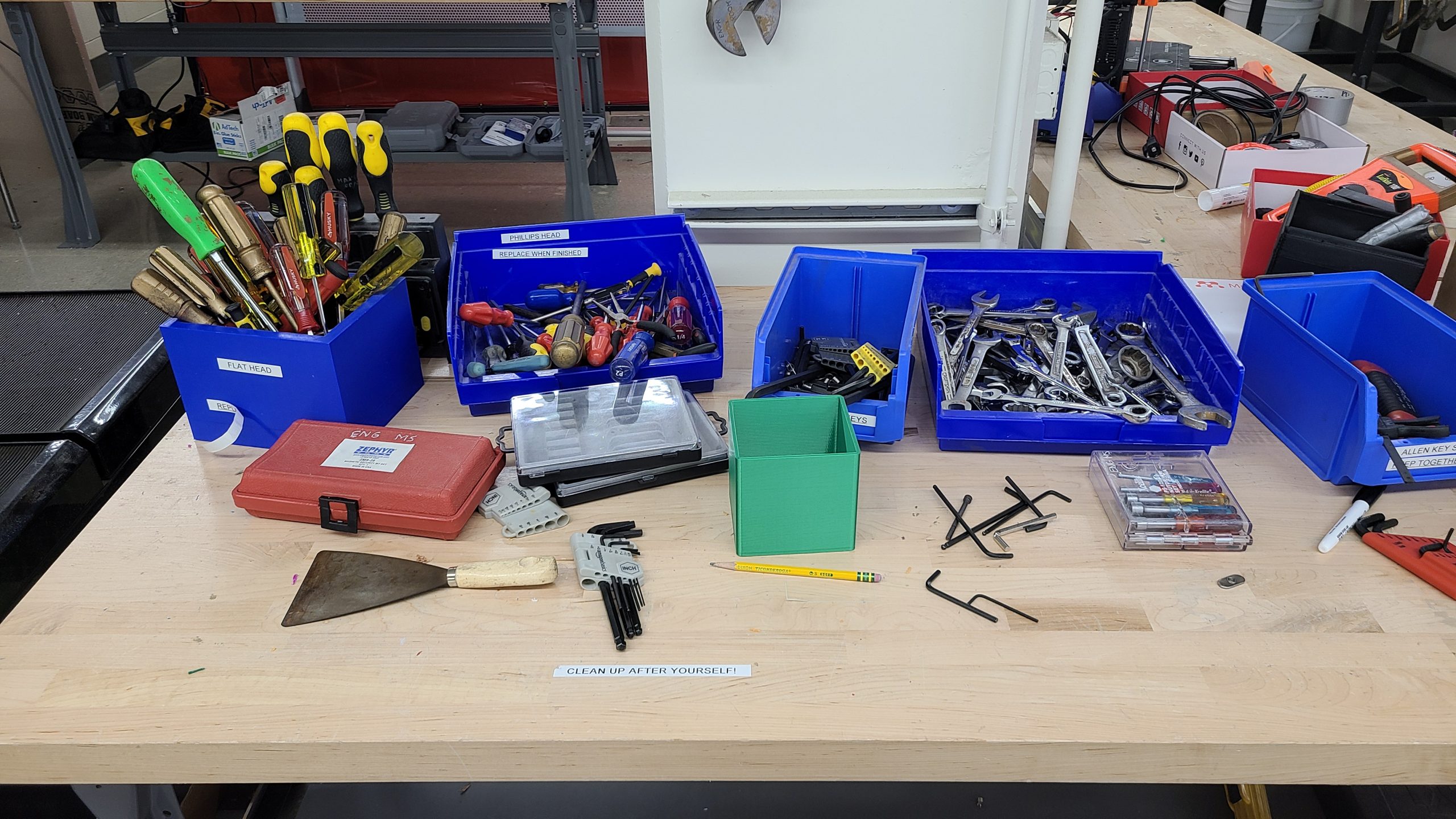
Dremel
Please inform the Mentors before using the Dremel and proceed with the following rules:
- DO NOT harm yourself or others
- DO NOT destroy the Dremel in the makerspace
- Always return the Dremel to where you found it after using it
- If you hear a SCREECHING sound from you Dremel, cease operation immediately.
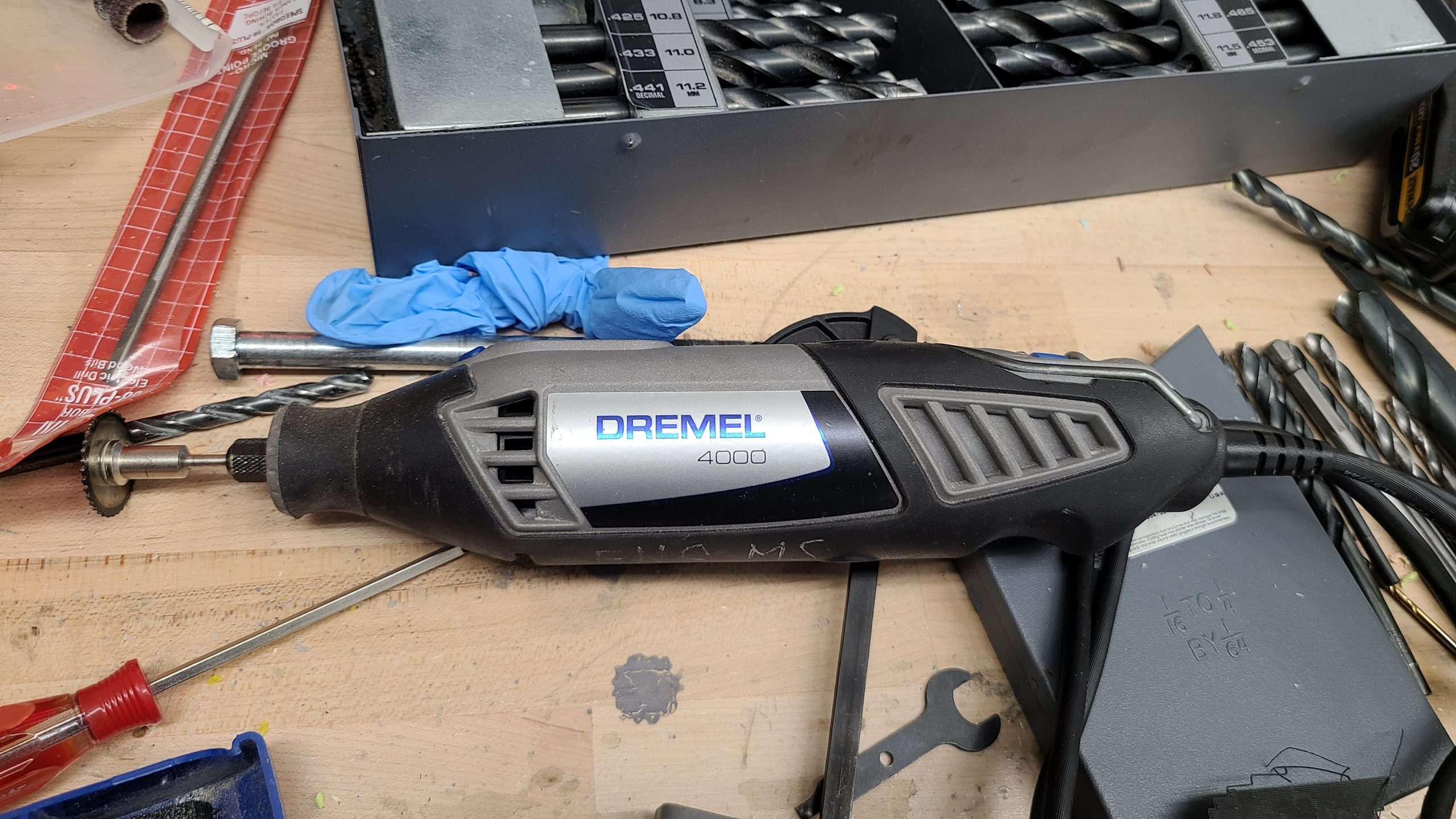
Drill
Please inform the Mentors before using the drill and proceed with the following rules:
- DO NOT harm yourself or others
- DO NOT destroy the Drill in the makerspace
- Always return the Drill to where you found it after using it
- When drilling on a table, use BUFFER material (i.e. a thick piece of wood) under the drilled material so as to not drill holes in the table
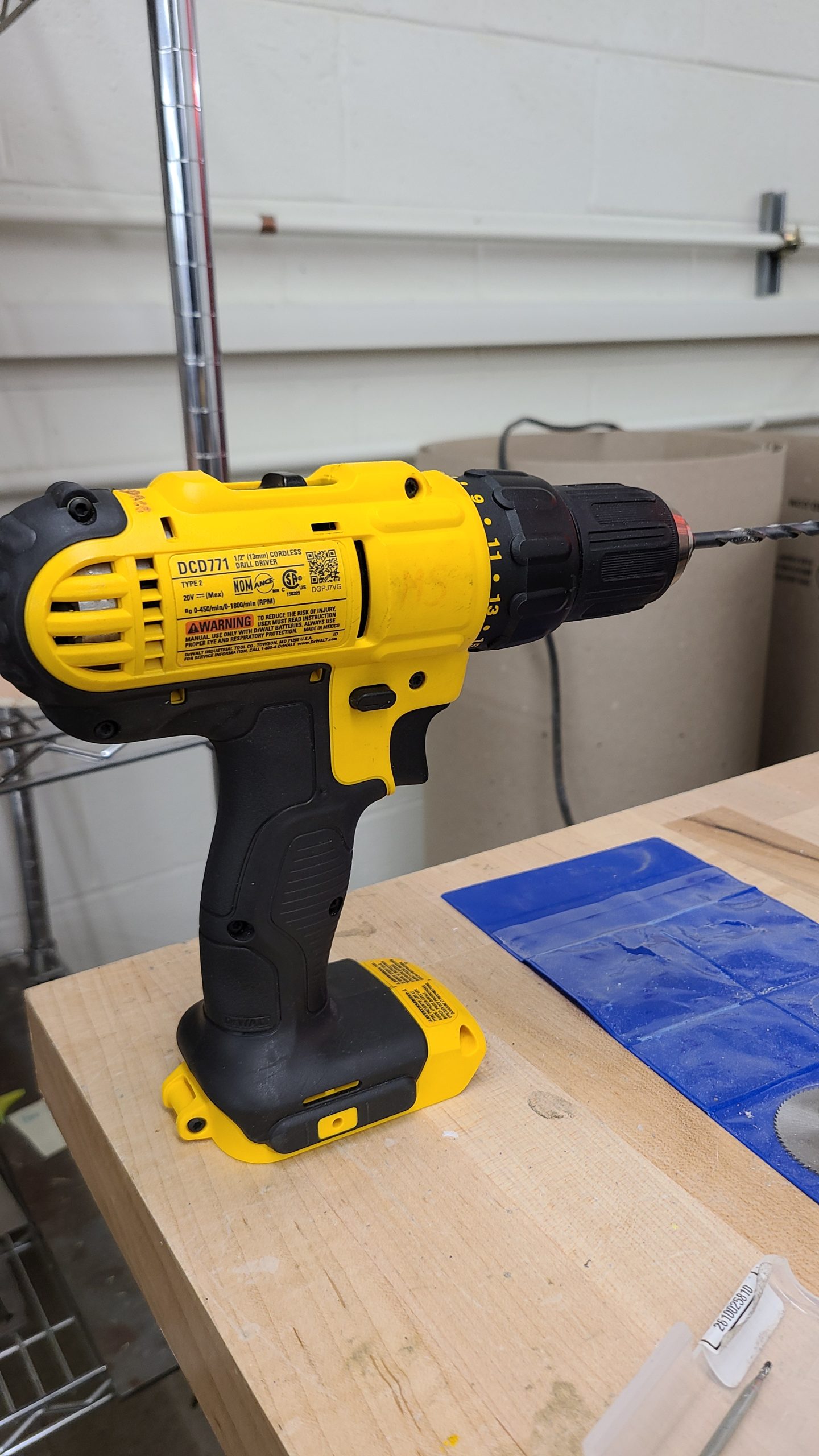
Band Saw
Contact the mentors if you want to use the band saw. They are locked and the mentors will find you the key.
Proceed with the following rules:
- DO NOT harm yourself or others
- DO NOT destroy the Saw in the makerspace
- Use a PUSH STICK to prevent cutting your fingers
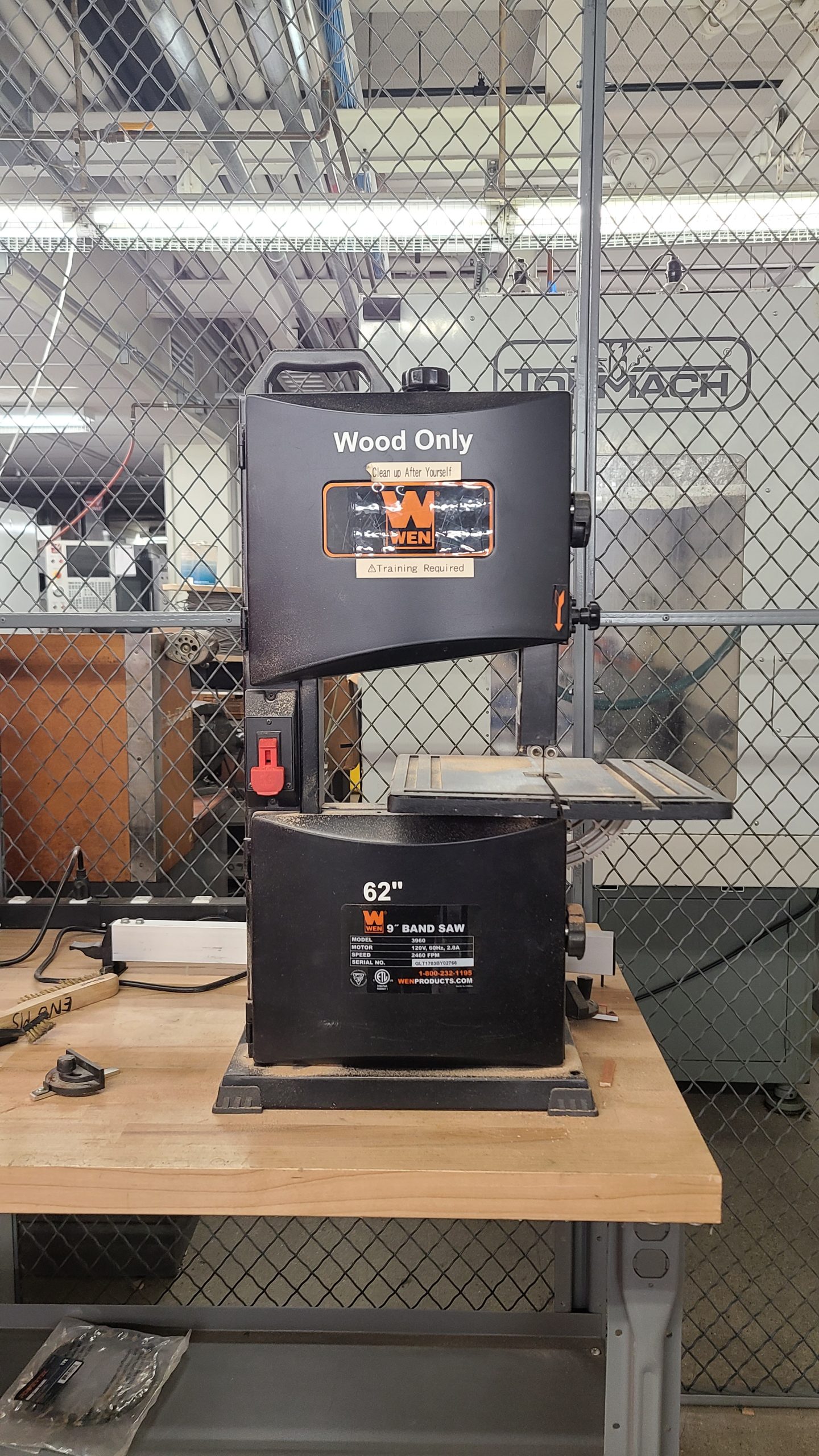
Judging

The HAcK technical competition will be judged by a team of 4 to 5 guest judges who will review presentation materials prepared by the teams in order to determine the winners.
Teams will be provided a Judging Criteria to guide them in the creation of their HAcK project, including relevant design and functionality requirements, as well as guidelines for their final presentations. Please also refer to the HAcK Rules and Submission Guidelines when they are posted after the HAcK reveal for more information!
Judging Criteria
The judging criteria is divided into three main sections:
1) Robot Functionality & Features, worth 60% of total score
2) Presentation, worth 30% of total score
3) Organization of Supplementary Materials, worth 10% of total score
Sections 1) and 2) will be evaluated by our team of guest judges. Section 3) will be evaluated by our team of mentors.
Please view the full itemized rubric here.
Submission Guidelines

Let’s see what you’ve come up with!
Once you’ve finished perfecting your robot, it’s time to submit your work. To do this, all teams will create a design review presentation, a ten-minute video where they explain their design process from start to finish, showcase relevant CAD models and code snippets, and demonstrate their final robot’s performance. These presentations will be due on the morning of Tuesday July 26th and will be evaluated by the team of guest judges. Teams will also turn in supplementary materials at the end of HAcK on Sunday for the mentors to review.
An automatic disqualification will be applied to teams that do not submit all required materials.
Teams will be required to submit the following materials in order to determine the winners of the HAcK challenge and to evaluate each team’s progress over the course of the competition, by Sunday, July 24th at 11:59 PM:
1) All CAD files of your robot (Upload to GrabCAD)
2) All code files used by your robot (Upload to GitHub)
3) All photos of your robot’s appearance that you intend to showcase as part of your presentation
4) All videos of your robot’s performance that you intend to showcase as part of your presentation
5) All screenshots of your code and CAD files that you intend to showcase as part of your presentation
After 11:59 PM on Sunday, no code or CAD files may be modified. Any photos or videos of the robot not submitted before 11:59 PM Sunday may not be included in the design review presentation. Similarly, any screenshots of code or CAD files not submitted before 11:59 PM Sunday may not be included in the design review presentation. So be sure to take ample screenshots prior to the deadline.
Code and CAD files will be reviewed by the mentors in order to evaluate each team’s Organization of Supplementary Materials score.
Code, CAD, and Photo/Video Submission Form
Photo and Video Guidelines
Smile for the camera! Each team will be taking photos and videos of their robot in order to showcase its capabilities and aesthetic features. These photos and videos will be included in each team’s design review presentation as a key point of evaluation, and each team is responsible for recording and submitting their own photos and videos.
Specifically, teams should demonstrate with these photos and videos the following things:
- That the robot can drive forward and backward, and turn left and right
- That the robot can pick up both types of boxes and place them in its backpack
- That the robot can display 3 different faces/expressions
- That the robot can dance
For movement, stability and whether the robot is controlled via Bluetooth will be considered. For box manipulation, partial credit will be awarded to teams that demonstrate their robot’s ability to pick up only one, but not both boxes, or that demonstrate an ability to either pick up a box or place it in the backpack, but not both. For display of faces, the number of faces displayed will be considered. Finally, for dancing, the number of components involved in the dance as well as the overall style of the dance will be considered. (Students are allowed to select a song of their choice for their robot to dance to; however, musical taste will not be a factor in judging.) Aesthetics of the robot will be considered, including its exterior appearance as well as its interior appearance.
All photos and videos taken of your robot to be included in your presentation must be taken in the Field of Play. During the last few hours of the day on Sunday, timeslots will be made available for teams to sign up for one of the three Field of Play areas to photograph and video their robot. Mentors will direct you on how to position your robot when taking videos and photos.
You will submit the following photos and videos of your finished robot:
At Least 6 Photos*
1) Top view (looking down on your robot)
2) Front side (one picture for each LCD screen face)
3) Left side
4) Right side
5) Back side
6) Guts (interior of robot)
* In addition to these photos of the robot itself, you will submit all screenshots of your CAD designs and code that you intend to showcase in your design review presentation. Screenshots of CAD and code are included in the judging criteria, so consult the rubric for more information on what to provide. You are also encouraged to submit additional pictures of previous design iterations (either CAD screenshots or prototype photos) as part of your demonstration of your iterative design process, which you may then later include in your design review presentation. CAD and code screenshots are due at the same time as all other photos.
4 Videos:
1) Driving – must demonstrate your robot driving forward and backward and turning left and right (max duration: 30 seconds)
- Robots will start in one corner of the Field of Play facing the wall and must start by driving backwards out of the spot. They will then stop, turn left, drive forward, and finally turn right.
2) Picking up Box Type 1 and placing it in backpack (max duration: 15 seconds)
- Robots will be positioned approximately 2 centimeters away from the “TIE Fighter” box (not touching) and must be shown picking it up (lift it in midair). The robot must also be shown placing the box safely in its backpack.
3) Picking up Box Type 2 and placing it in backpack (max duration: 15 seconds)
- Robots will be positioned approximately 2 centimeters away from the “Atomic Death Star” box (not touching) and must be shown picking it up (lift it in midair). The robot must also be shown placing the box safely in its backpack.
4) Dancing (max duration: 15 seconds)
- Take center stage! Your robot wants to be in the spotlight, so it will be placed in the center of the Field of Play and perform a preprogrammed dance (no steering)! In the video you must show yourself pressing a button to prompt the dance to begin on your laptop and then show your robot’s dance.
* Note that the speed at which the robot performs its tasks in itself does not matter, provided that it can accomplish (or attempt) each task within the time limit of the video. However, teams whose robots are shown performing tasks more quickly will likely have more time left over to present other material during their design review presentations, and thus it may be moderately advantageous to have a robot that performs with greater speed.
GitHub and GrabCAD Submission
GitHub Instructions:
- A private repository created in GitHub with mentors added as collaborators must be created.
- GitHub usernames of mentors: pjil127, nturner0, Ben-Dove-666, kendallm2201, Wfdo97, rivalparchment3
- Source codes or files on GitHub repository above must reflect the Final Prototype – any unnecessary files or codes must be removed.
- File names should always have the following format “<TeamName>_<ReasonableNameOfFile>”
- For example, “TeamHAcK_BluetoothCode.ino”
- Comments are necessary throughout your code.
- A README.md file must be included, and it should contain a brief description of each file in your private repository. Follow the template in this link.
- Submission will be the link to that private repository. Submit your GitHub link here.
- Helpful Guidelines:
GrabCAD Instructions:
- The final submission of CAD files should be in the format shown in the picture below.

- Move all of the original CAD files provided (except for the main assembly) into their own “Unmodified Parts” folder.
- Make sure to also make a GrabCAD project and share it with all of the following emails:
- william.friet@hotmail.com
- kendallm2201@gmail.com
- pantigjillian0@gmail.com
- guoyimini@gmail.com
- nturner1@g.ucla.edu
- shelardreshan@gmail.com
Presentations
Teams are required to submit their design review presentation by Tuesday, July 26th, at 10 AM. Presentations must be 10 minutes or less and given in recorded video format, where all team members present equally on their design process and demonstrate their finished robot’s functionality via photos and videos. Teams are required to use Google Slides for their presentations and embed all photos and videos of the robot within the slides themselves. The guest judges will be evaluating each team’s Robot Functionality and Features score as well as their Presentation score based solely on the content of the team’s video presentation, so ensure that you showcase all of your robot’s functionality within the presentation itself. Engineering communication practices demonstrated in the presentation, such as clear descriptions of the designs and code used, the iterative design process, and future improvements, will also be considered. For detailed information on presentation criteria, refer to the judging rubric.
Presentations will be submitted in three parts:
1) Video File (MP4)
2) YouTube Link (Instructions on how to upload a video to YouTube can be found here)
3) Link to Your Google Slides
About Us
Meet the Mentors
My name is Warnakulasuriya Fernando and I am majoring in Electrical Engineering. I am interested in Embedded systems and robotics. I grew up in Sri Lanka, a small country below India, and moved to Anaheim area 4 years ago. I transferred from Cypress College to UCLA in Fall 2021 and participated in the transfer bridge program. These days I am also working in LEMUR lab, lab which specializes in robotics, in UCLA. At last, I am excited to meet you guys and please feel free to ask any questions about anything.
I am a rising 3rd year Aerospace Engineering Major from San Diego, CA. I have been interested in engineering since high school where I was a member of my school’s robotics team. Since coming to UCLA I have joined ASME, participating in FADE as both a student and a mentor. In my free time am an avid Dungeons & Dragons player and a gamer. I am excited to get to know all of you and I wish you the best of luck at UCLA!
Hi, my name is Ming and I am a rising 4th year majoring in Electrical Engineering. I am originally from Shanghai China but now I live in LA. For the past year I had been involved in the Aircopter project at IEEE. The project revolves around building a drone from the ground up. I have leant some valuable skills from PCB layout to a lot of C programming. I had also been working for a neuroscience research lab. For me It has been a fascinating experience to witness all the work that goes behind the discoveries of knowledge of the human body. When I am not occupied with school I like to work out and read books. I hope this is going to be a summer full of learning, socializing and adventures for all you who is reading.
Hi everyone! My name is Kendall, and I am a rising 2nd year Mechanical Engineering major from San Jose, California. My main interests are aerospace, software, renewable energy, and biomedical devices (especially prosthetics design!), so I’m pretty much all over the board–but I generally love interdisciplinary projects and anything with a practical real-world impact.
Some student organizations I’m a part of include Rocket Project at UCLA (Prometheus Electronics Subteam Co-Lead!), Tau Beta Pi, and NSBE (National Society of Black Engineers), which I’ll be serving as Programs Chair for this coming year. I also volunteer in a research lab studying racial bias in infrared thermometers and starting in the fall will be working for UCLA as an Engineering Ambassador, so I’ll get to take people on tours and show them what UCLA Engineering is all about!
Outside of activities (and when I’m not stressing for midterms), I love to do movie nights with friends, listen to music albums I’ve never heard before, and volunteer last-minute for engineering outreach events that get lost in my email. And I don’t know when sleeping became a hobby of mine, but let’s be honest: naps are great too.
I’m really looking forward to getting to know all of you over the course of this summer and creating some awesome projects together!
Hey hey hey! My name is Jillian Pantig (Jill for short). I am a rising senior majoring in Computer Engineering at UCLA, and just like most of you, I am also a transfer student – coming from Irvine Valley College. When it comes to talking about my extracurriculars, I am involved in several research projects as an Undergraduate Robotics Research Assistant at Professor Ankur Mehta’s lab called LEMUR. Outside of school, I like biking, eating, and playing games.
I look forward to meeting each and every one of you. I can not wait to have so much fun with you guys!
Hey there! My name is Nick. I’m a rising 3rd year Electrical Engineering major. I am excited to introduce myself as one of the HAcK and Basic Training Mentors for the ’22 Accelerator Program. A few things about myself: I am from Rocklin, CA. At UCLA, I am a part of IEEE – I’ve completed two projects with the organization, and I served as Treasurer last year. This summer, I am working in a professor’s lab, researching communication device implementations on FPGAs. Some of my hobbies include: tennis, chess, ukulele, and gaming. I look forward to meeting you all!
Hello, my name is Wes Uehara. I am the Director of the Engineering Transfer Center and look forward to working with all our UCLA Samueli Engineering Transfer Students! I have worked with for the University of California system since 2000. First as an academic counselor at UC Irvine. I joined the Bruin family in 2004 as the Education Director for the Center for Embedded Networked Sensing, a NSF Science & Technology Center headquartered at UCLA Engineering. In 2012, I transitioned to the Dean’s Team to help run high school outreach programs. In 2017 I was hired as the School’s first Community College Outreach Coordinator and opened the doors to the Engineering Transfer Center in 2018. In my free time I enjoy spending time with family and friends. I am a nomad in spirit and love adventuring off and wandering into the world. I have been known to dabble in photography, music (I play a little ukulele and piano), and my aging body is trying to transition from running to exercise (like hiking & yoga) that has less impact. I am not human until I have cups of coffee in the morning.
Meet the Teams
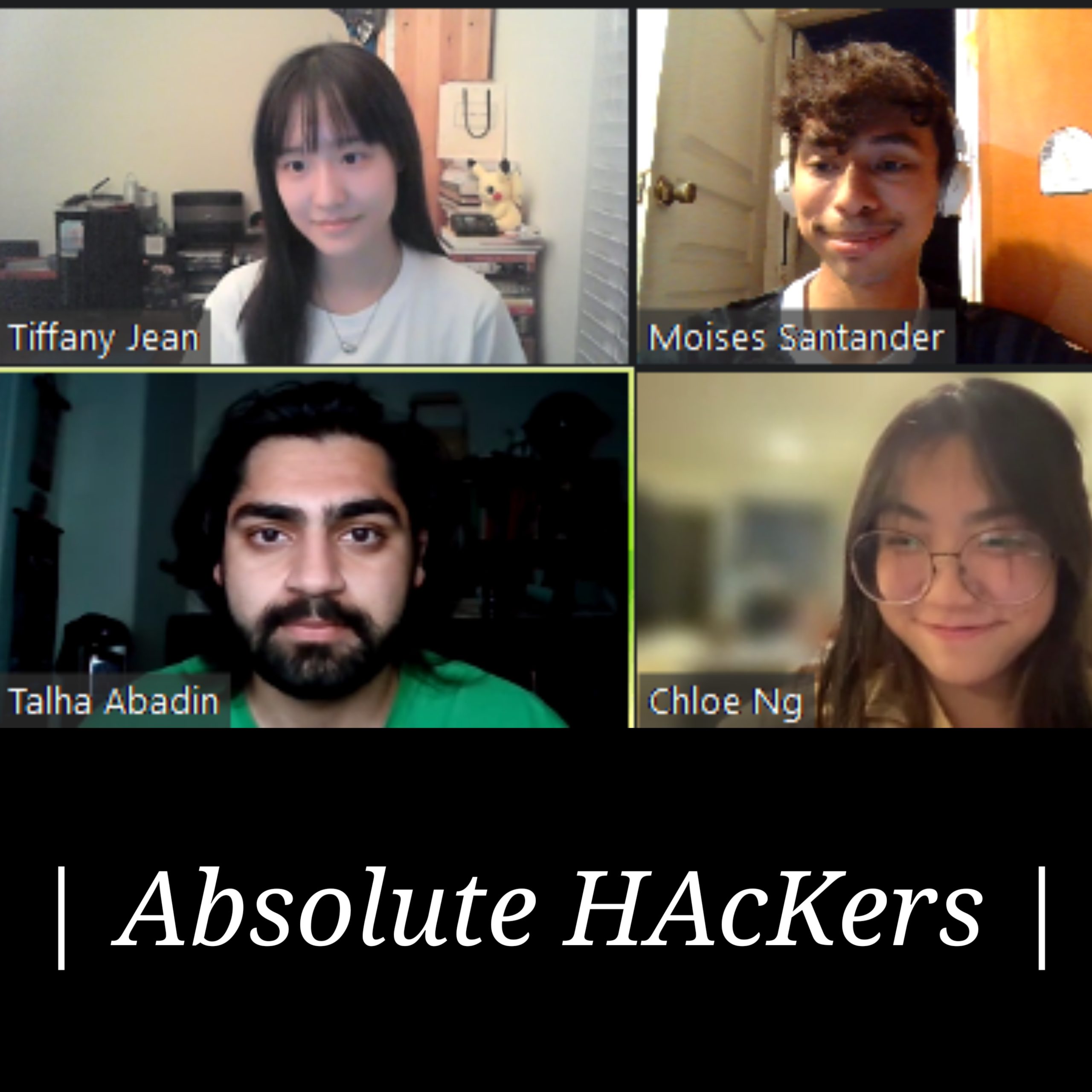
Team 1: Absolute HAcKers
Talha Abadin
Moises Santander
Tiffany Jean
Sing Jing (Chloe) Ng


Team 2: The Martian Maniacs
Jonathan Kim
Christopher Cisneros
Daisuke Asai
Minhao Ren
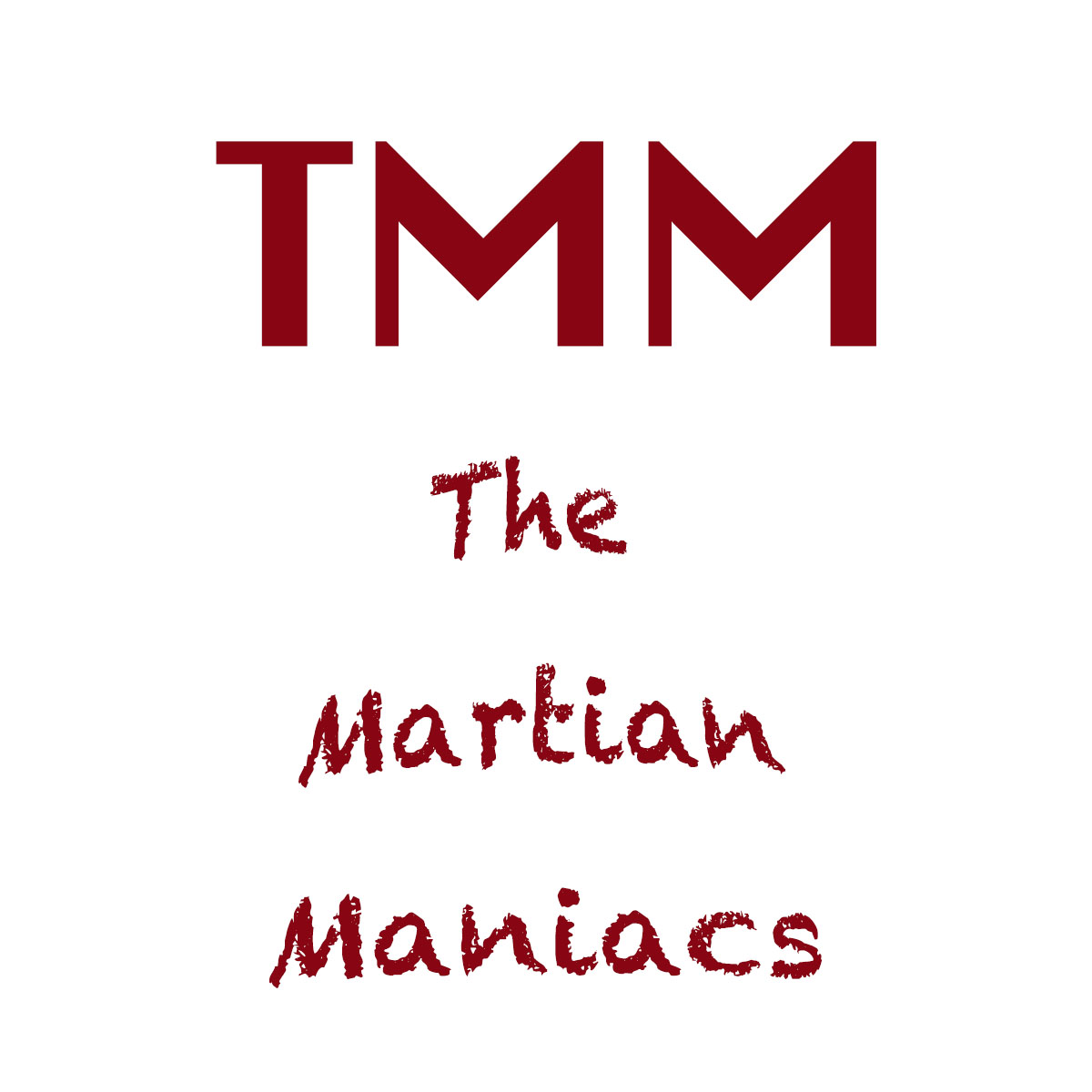

Team 3: Earthlingx
Jingwen ‘Jaelyn’ Fan
Richard Sandoval
Laura Gonzalez


Team 4: Hooks on Mars
Seoyeon Kong
Slava Ermolaev
Jordan Aviles

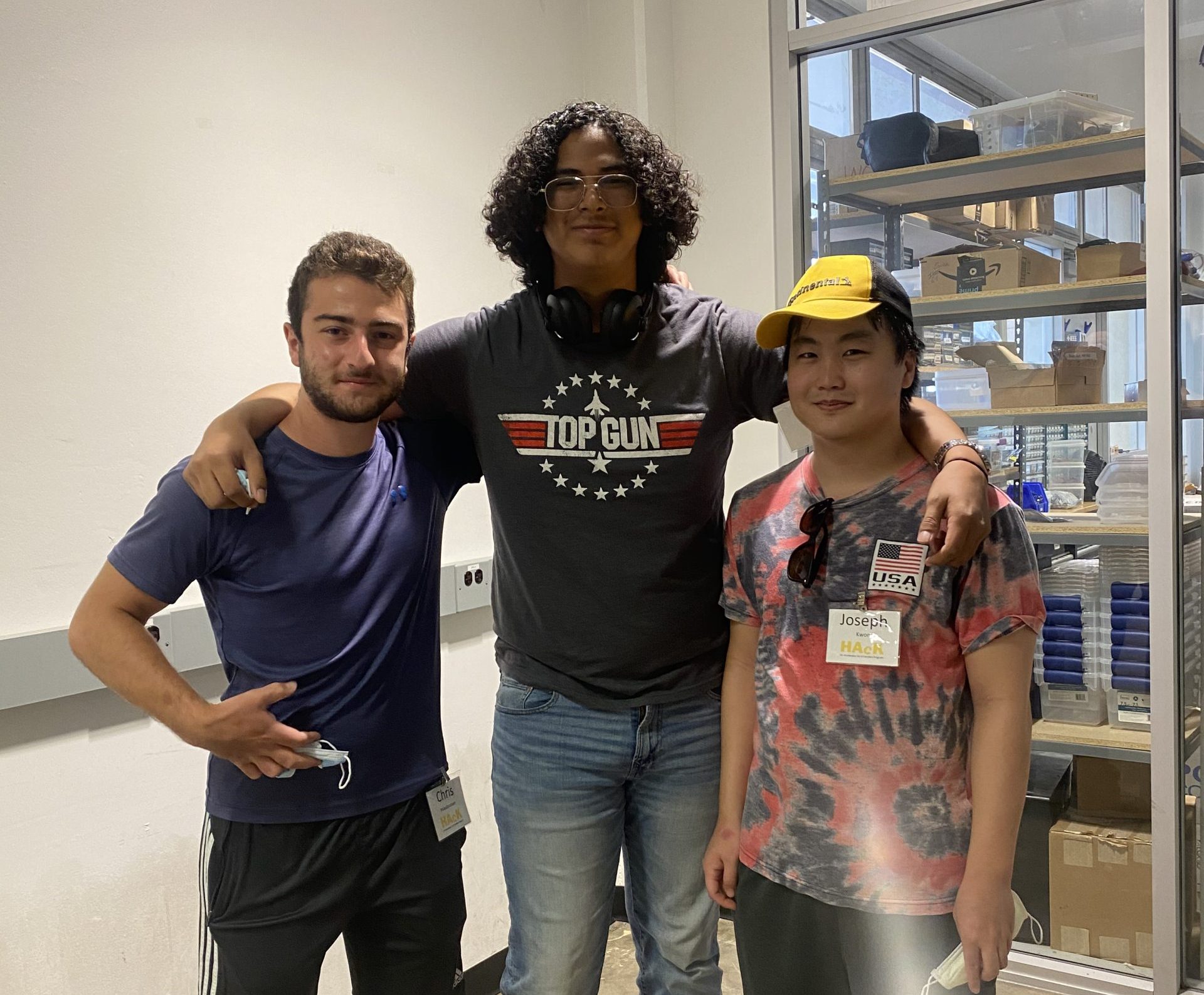
Team 5: Eclipse Robotics
Joseph Kwon
Chris Imasdounian
David Lopez
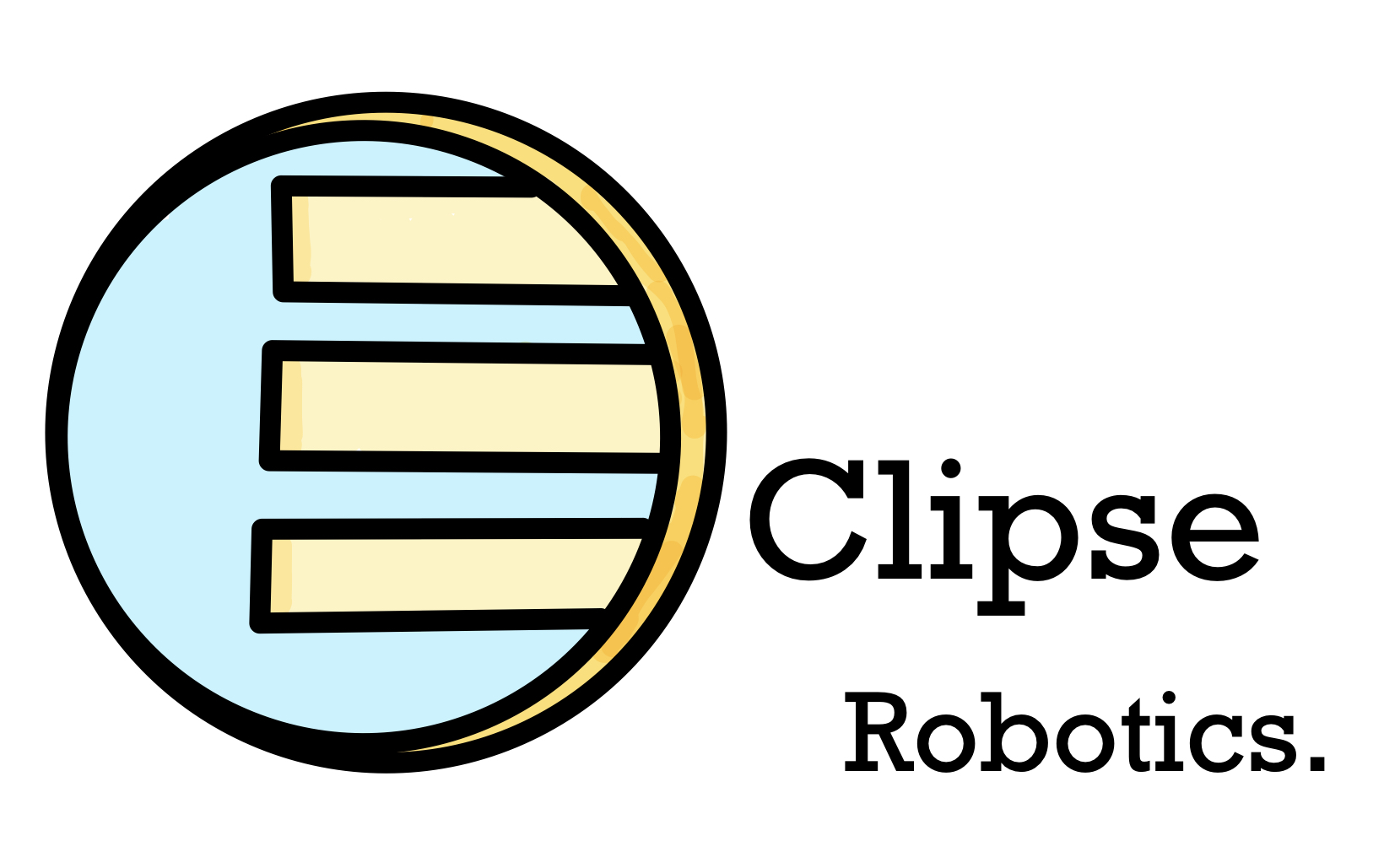
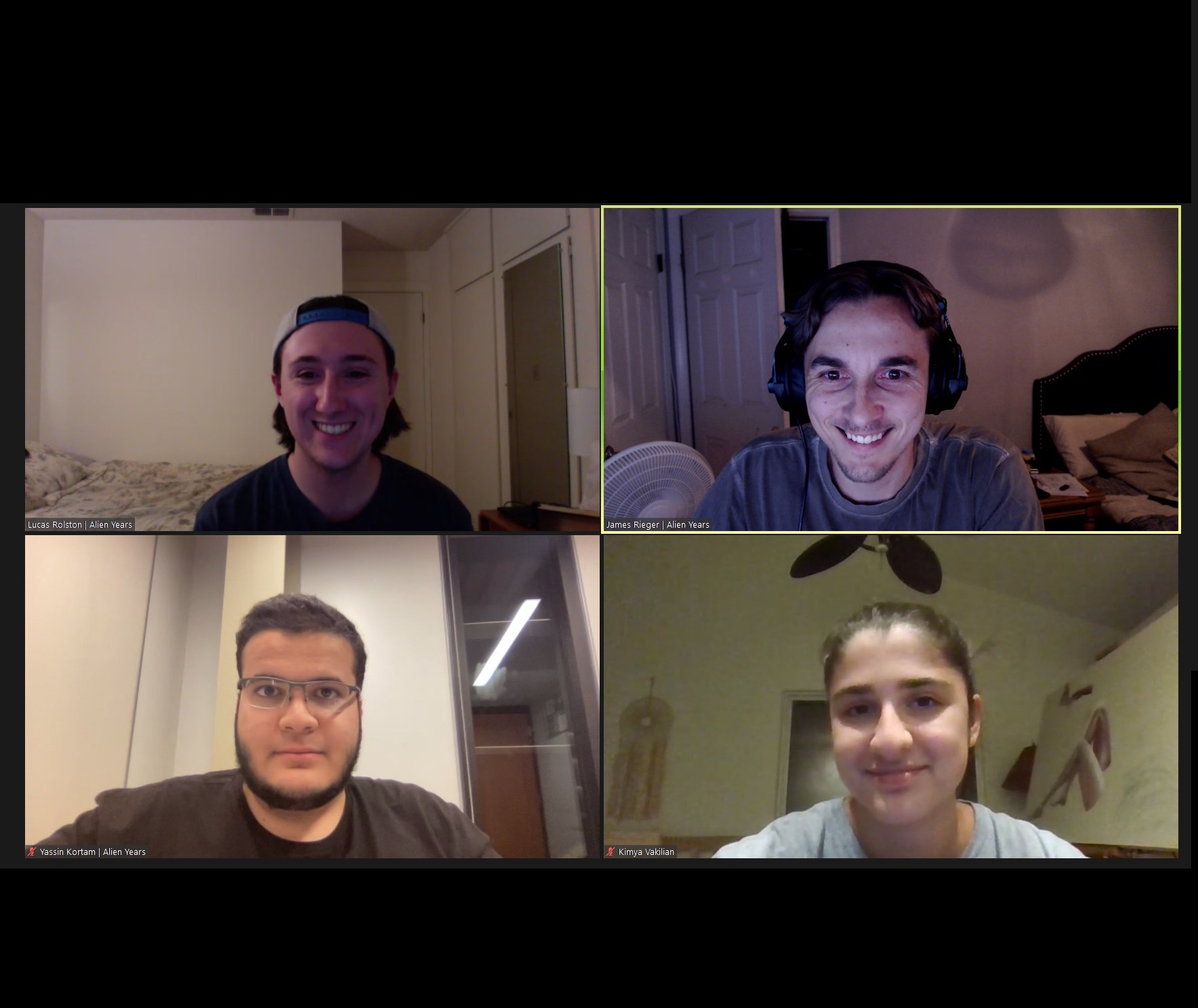
Team 6: Alien Years
Lucas Rolston
Yassin Kortam
Kimya Vakilian
James Rieger
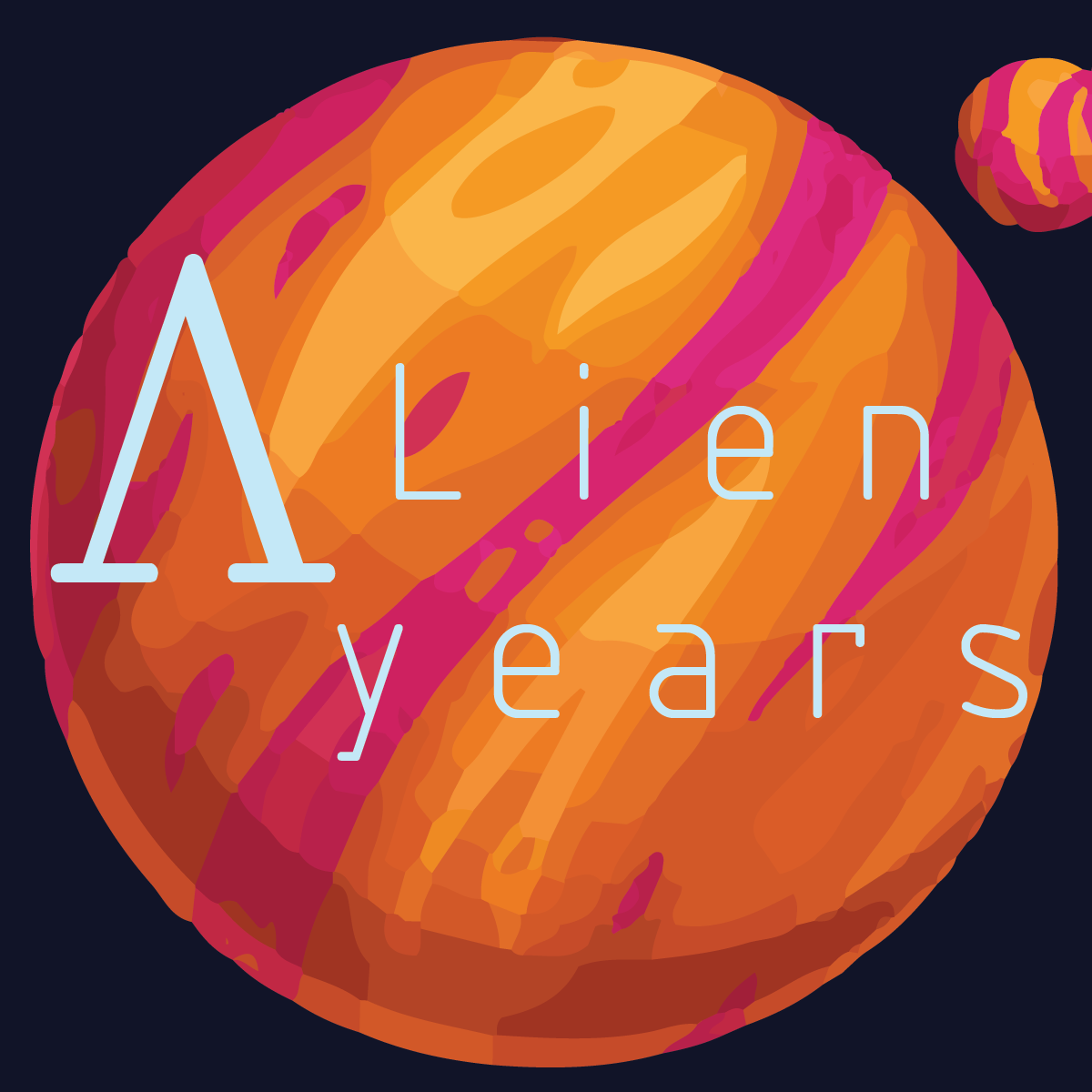
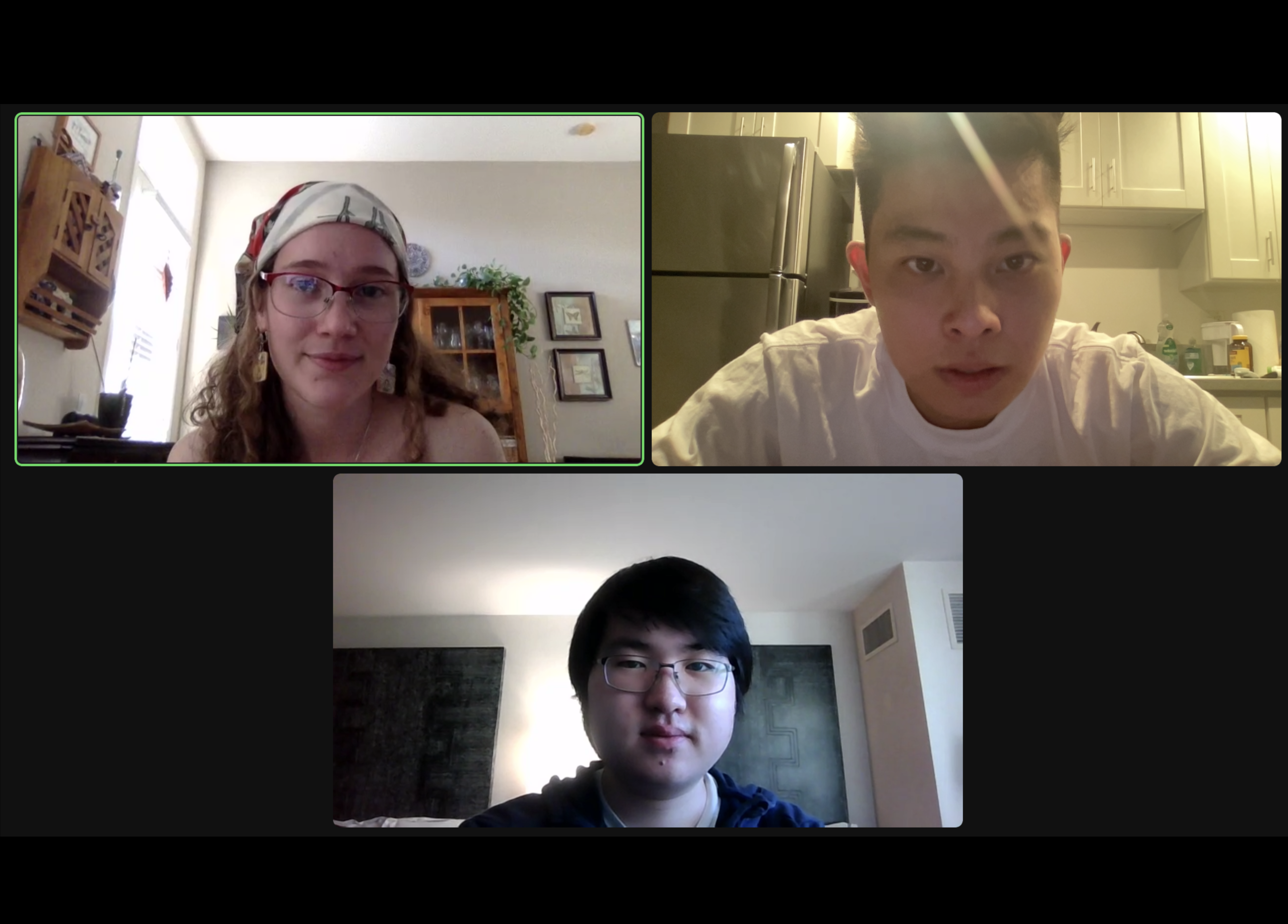
Team 7: Free Block-E
Julia Stoneburner
Shengjie Zhu
Phoenix Tsou

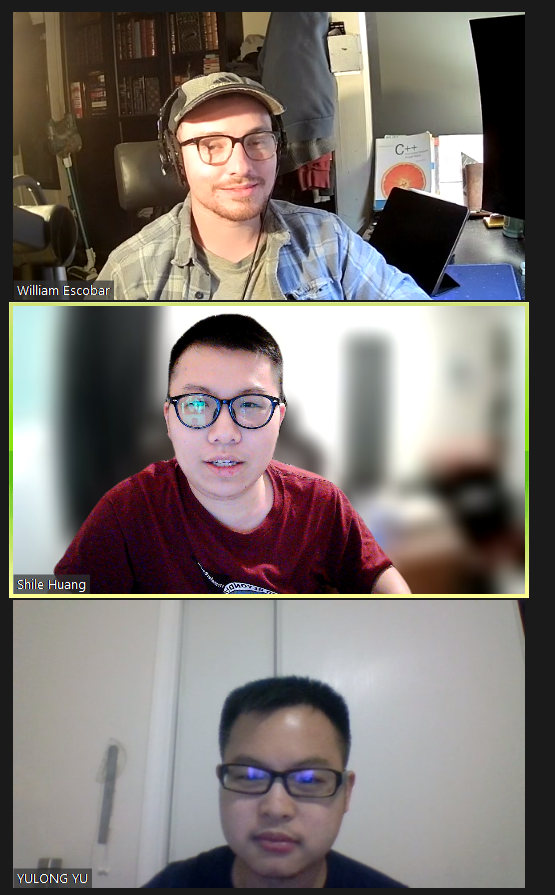
Team 8: H.E.Y-Bot
Yulong Yu
Shile Huang
William Escobar
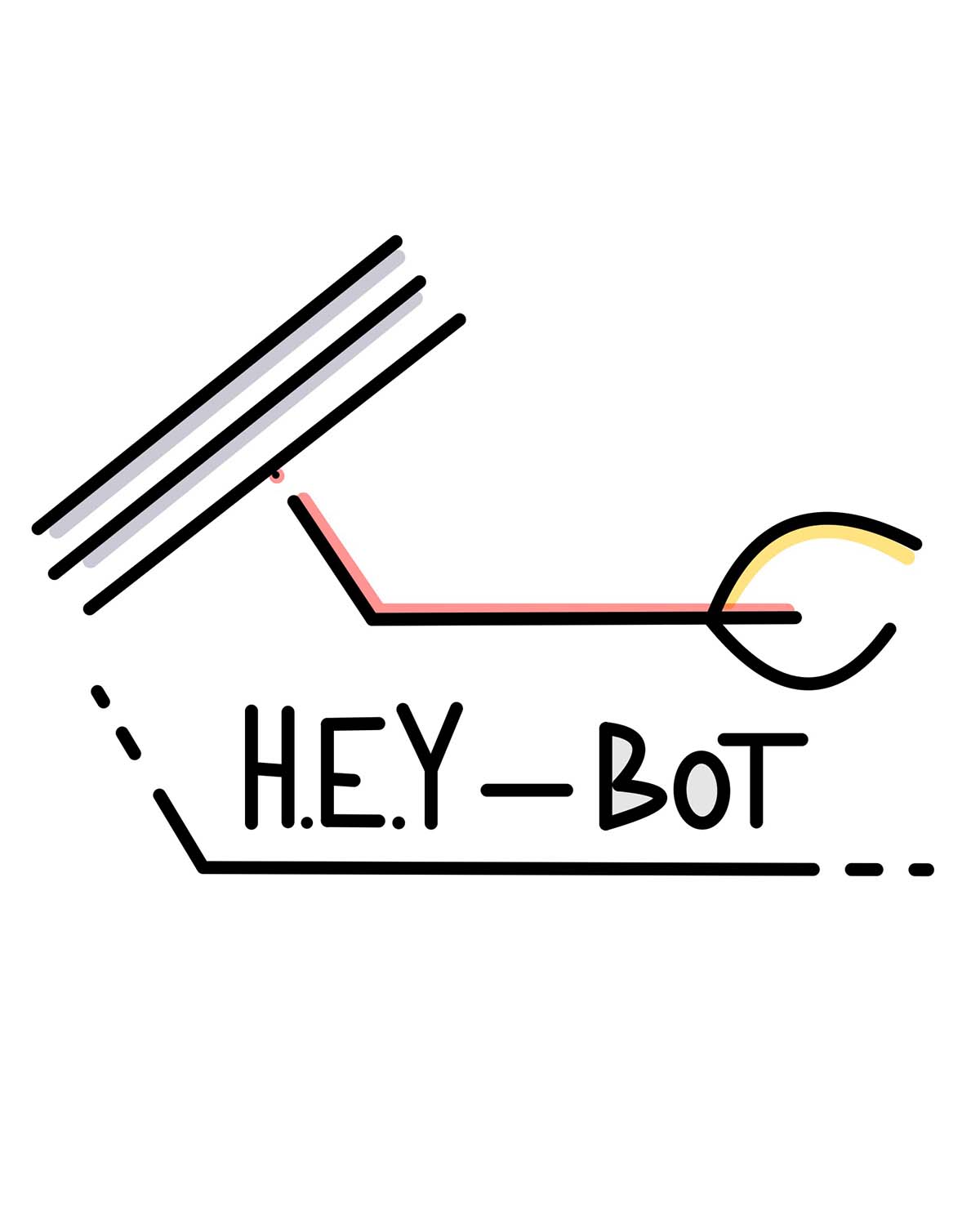
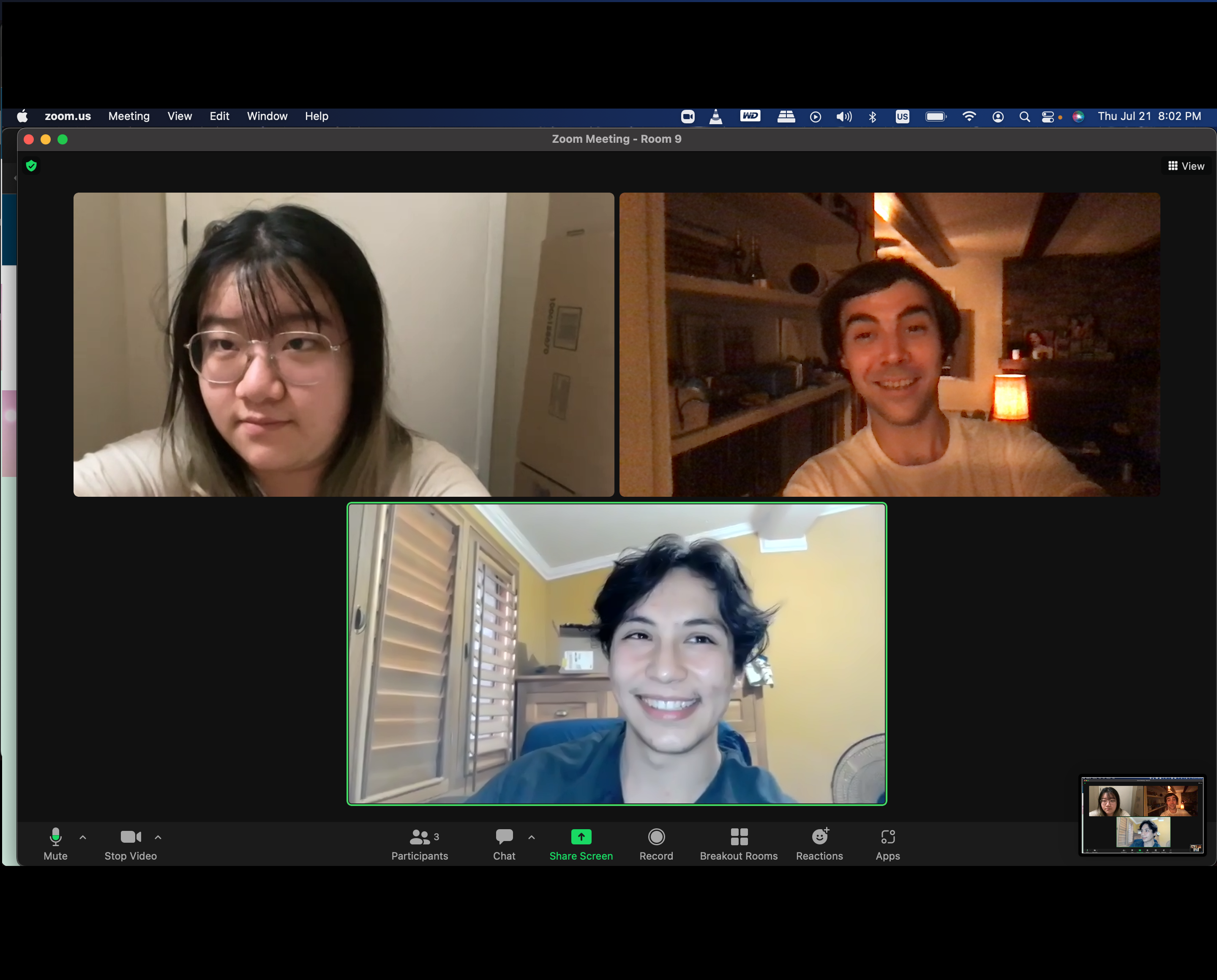
Team 9: RGB
Huxin (Nancy) Zhao
Kian Vaziri
Ethan Bobadilla
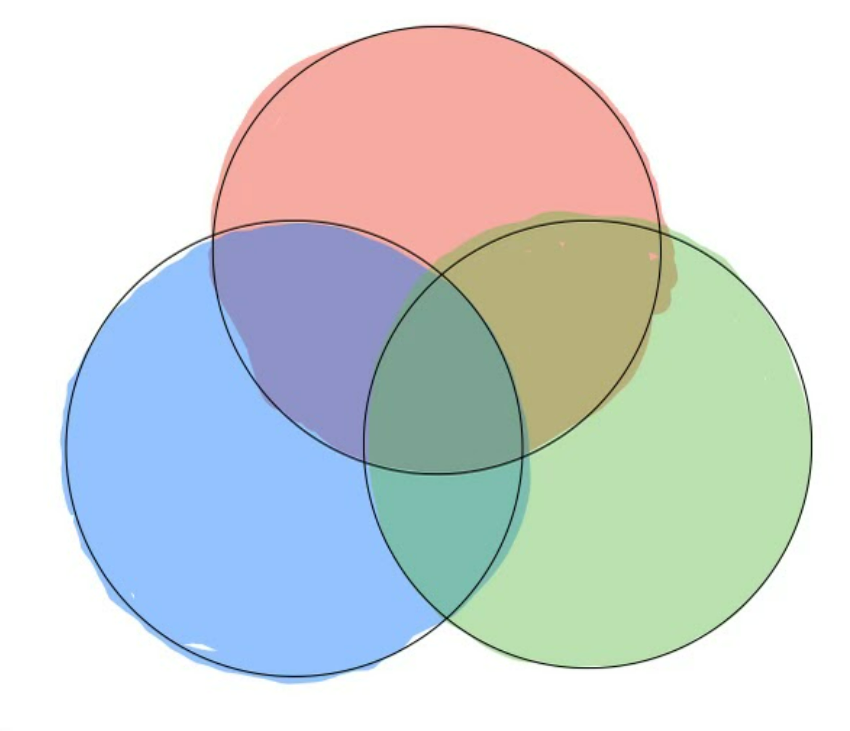
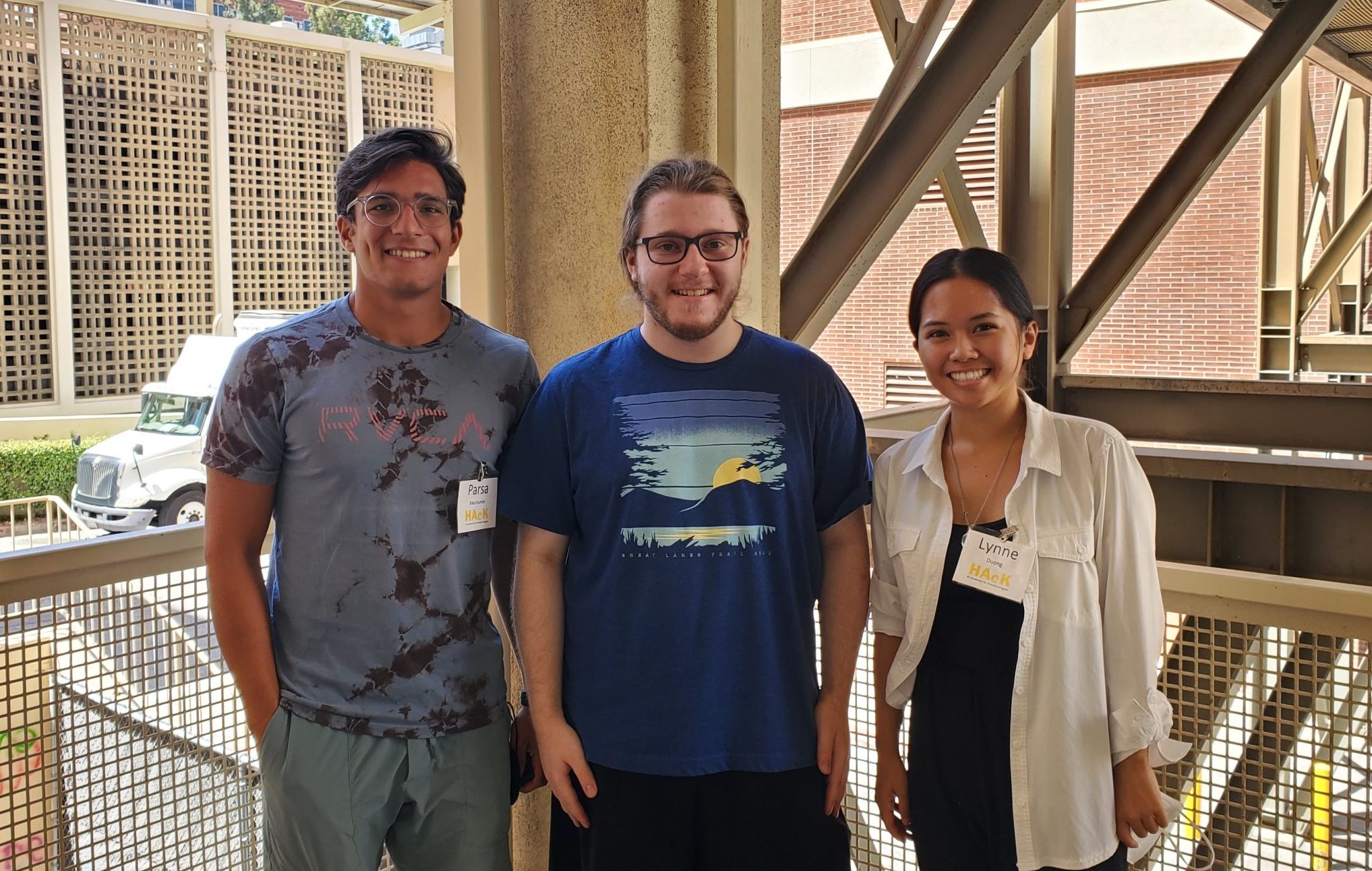
Team 10:
Lynne Duong
Steven Bash
Parsa Mazloumin

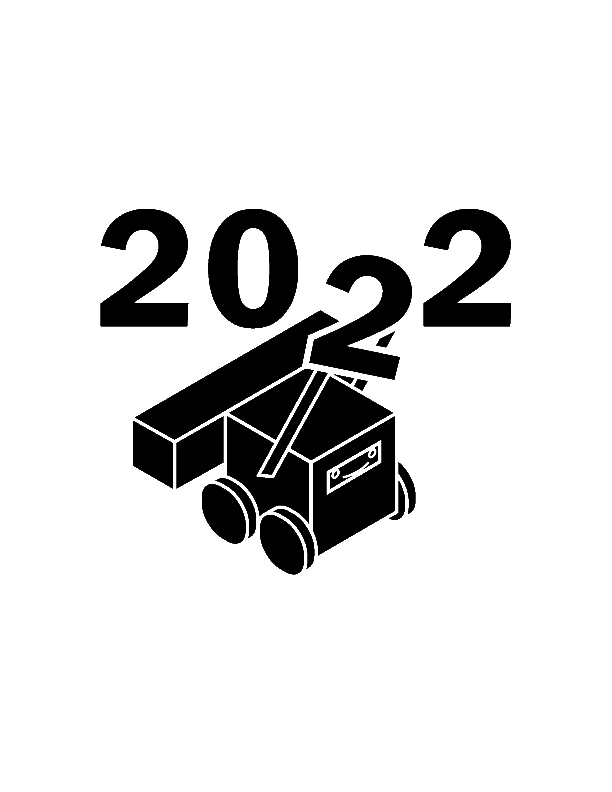
Frequently Asked Questions
What should I bring to HAcK?
Please bring a laptop with the Arduino IDE and SolidWorks downloaded if you have one, as all teams will need at least one shared laptop with each software. Please also bring a refillable water bottle.
Do I need to have participated in Basic Training in order to participate in HAcK?
Yes, participation in Basic Training is required for participation in HAcK. Basic Training provides a lot of valuable skills designed to support students through the HAcK project, which is why we require participation in both programs. However, if you were unable to attend all of Basic Training synchronously, please let Wes and the mentors know and they can coordinate with how to best assist you.
I'm not able to attend in-person for some or all of the days of HAcK. Can I still participate?
Likely yes, but let Wes and the mentors know. We’re making sure to divide the teams such that at least one person on each team will be able to attend in-person, so if you physically cannot be in-person, please contact Wes and the mentors if you haven’t already to let them know your situation.
When will we find out more about the HAcK project?
The HAcK design challenge will be announced July 21st at the HAcK 2022 Reveal! Refer to the schedule for more information.
Can we choose our own teams?
Because it’s important for the teams to be evenly balanced, teams will be selected by the mentors in order to ensure that all teams will have a variety of prior skillsets represented, as well as include at least one person who has indicated that they will be attending the HAcK in-person. Stay tuned for the team announcements at the Reveal on July 21st!
Will meals be provided during HAcK?
Yes, lunch and dinner will be provided during the three days of the HAcK competition (Friday, Saturday, and Sunday). We will do our best to accommodate dietary restrictions indicated during registration. We recommend that you provide your own meal accommodations if you have strict requirements.
Can I bring my own tools, parts or supplies.
The short answer is no. We want to provide an even playing field for all participants. Teams should not win because they have their own supplies, access to equipment, etc.
You should not be using any parts or supplies that are not provided to you by HAcK and you shouldn’t be using any of your own tools beyond laptops, calculators, writing tools, etc. If you have questions or ideas please contact a mentor.
Do I have to work at UCLA?
Yes. Members working on their team’s prototypes should be working in the MakerSpace where the prototype-testing stations will be located. Please check-in and out with a mentor each day. If you are not working on the prototype; then you are able to participate remotely. If you have questions or concerns about this please contact one of the mentors.
Sustenance at HAcK
Friday, July 22, 2022
- Lunch: Subway boxed-lunch meals (Turkey, Italian, Cold-cut combo)
- Mid-afternoon snack
- Dinner: Chipotle (chicken or steak burritos)
Saturday, July 23, 2022
- Lunch: Dominos pizza and chips (assorted pizzas)
- Mid-afternoon snack
- Dinner: Sunnin Lebanese (falafel or chicken kebab wraps) and chips
Sunday, July 24, 2022
- Lunch: In & Out (cheeseburger & fries)
- Mid-afternoon snack
- Dinner: Ono Hawaiian BBQ (chicken katsu & Hawaiian chicken-plate or Beef teriyaki & chicken-plate or white fish & lemon grilled chicken-plate)
Snack Barn – will be stocked with a limited amount of snacks and beverages for meals. Please limit your consumption as items will NOT be restocked.
Please plan your own meals if you have strict dietary restrictions and/or if you think you’ll need more than what we are providing. Please keep in mind that we do not have refrigeration available.
Please email the eTransfer Center for additional questions or concerns at etransfercenter@hsseas.ucla.edu.

